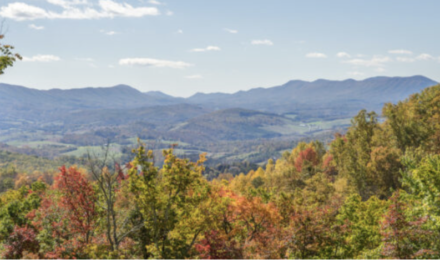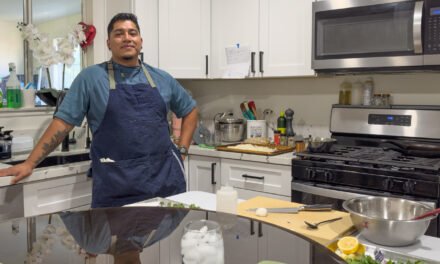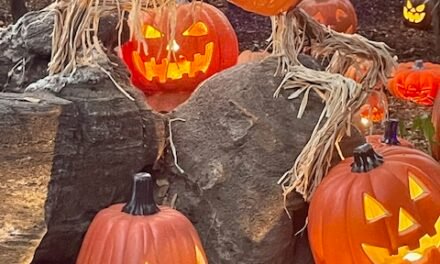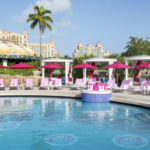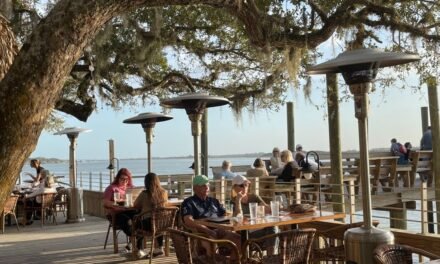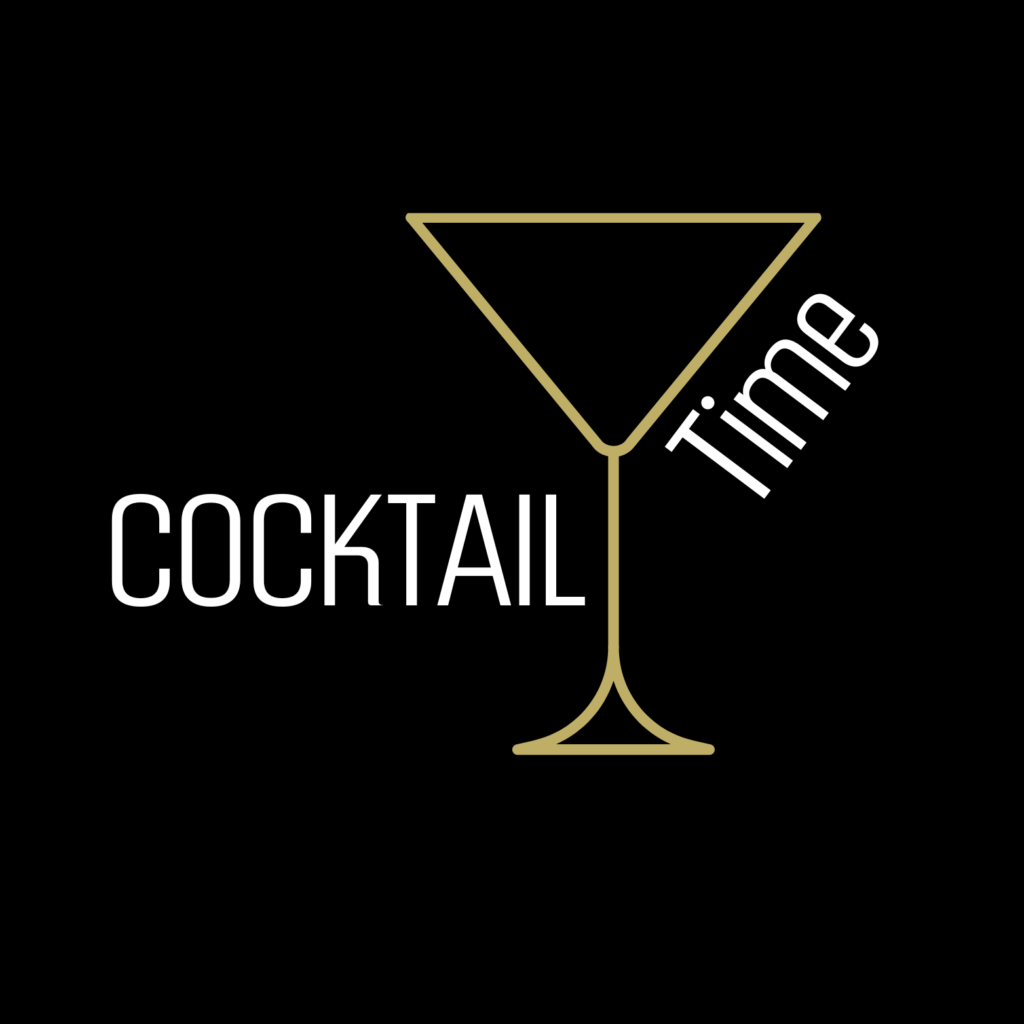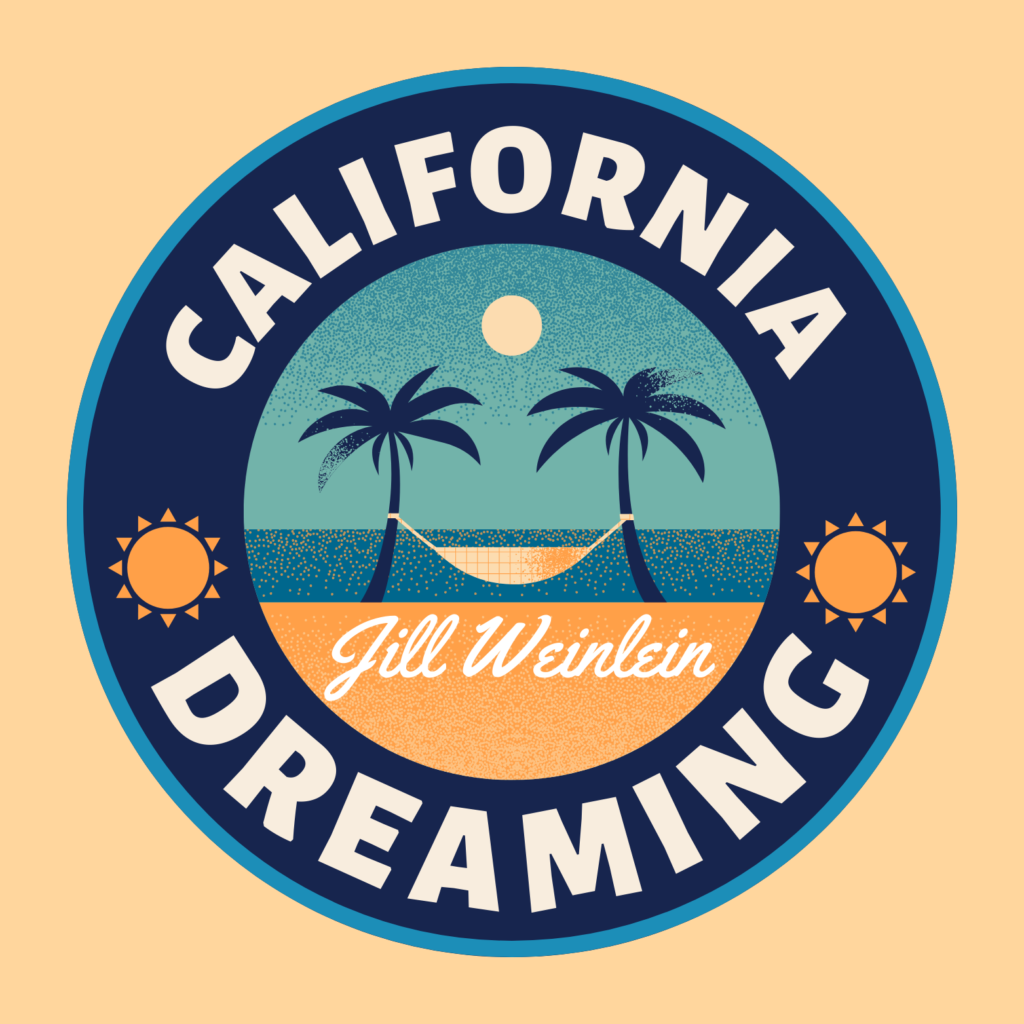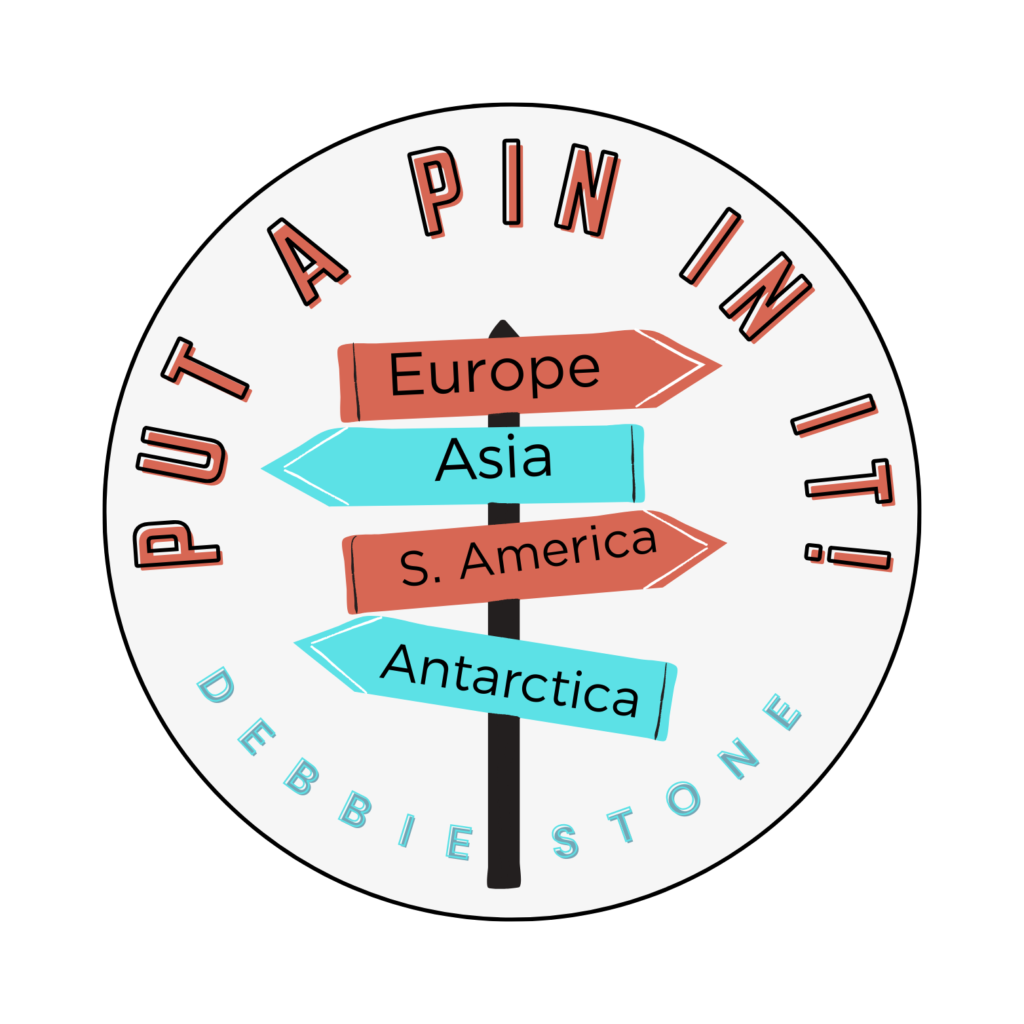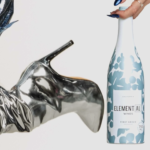
PUB CRAWLING LONDON’S IMMORTAL DRINKING DENS
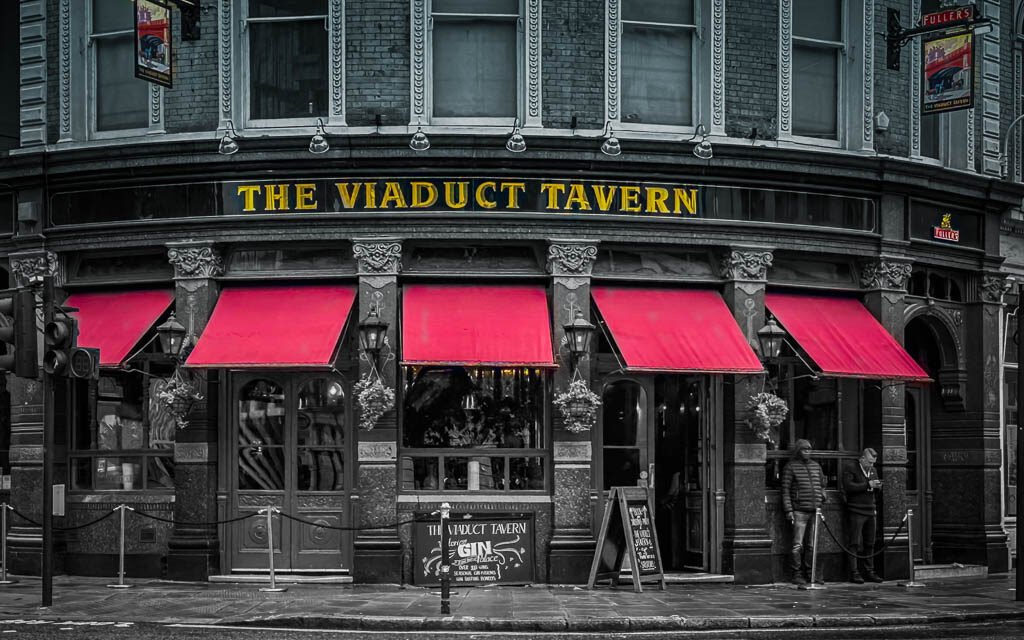
London’s immortal drinking dens have been part of the storied town’s cultural fabric for centuries. Swarthy smugglers, roguish pirates, drunken sailors, dreaded press gangs, a great fire, multiple wars, literary legends, inebriated philosophers, dubious politicians, spurned lovers, hell raising thespians, ribald poets, hedonistic rock stars, gentrification, and a global pandemic could not bring London’s celebrated pub culture to its knees. Shrouded in history, London’s boozers are rife with tall tales of excessive indulgence, scandals, and allegedly stories of spooky paranormal activity. These worn-in social shrines of yore have been the backbone of British society and provided a meeting place where people from all walks of life could order an amber elixir, soak in the atmosphere, and get drunk on history.
“THE LOCAL”
“You meet a better class of person in pubs.”
— Oliver Reed
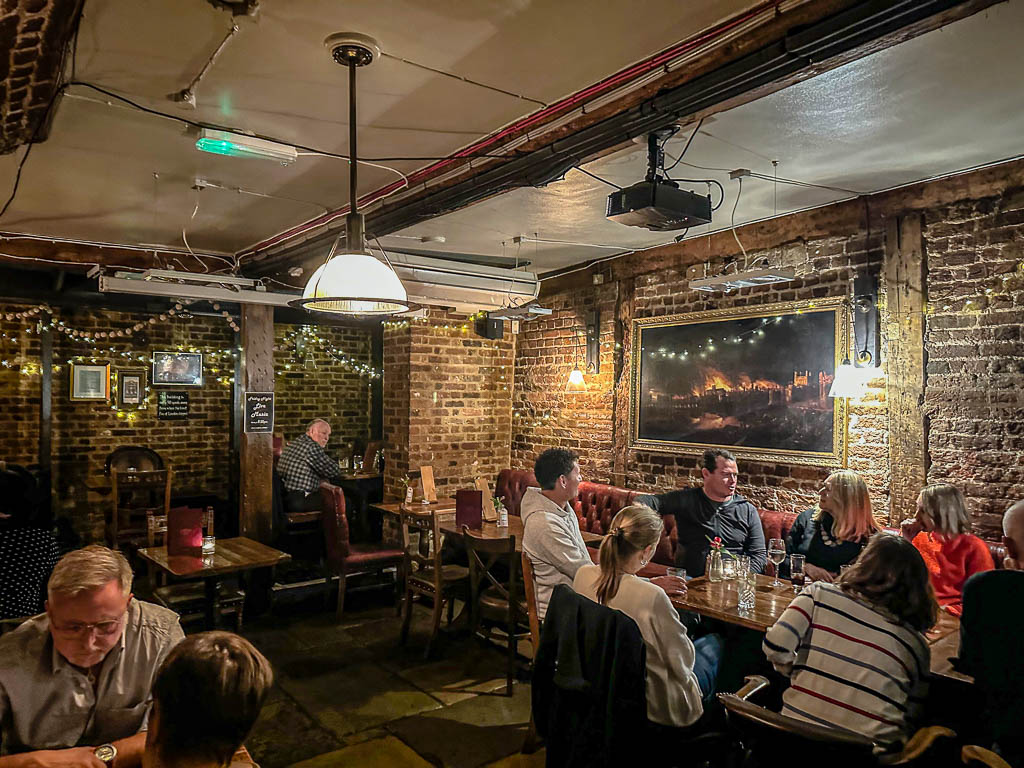
“The local.” Photo by Jett Britnell
Few things in life are more British than what’s known as “the local”; a pub where most patrons are regulars from the neighbourhood who meet up for pints of ale, spirits, wine, or hearty British food. Pub is an abbreviation of a public house, a term which dates back as far as the 1500s, or earlier. Whatever you wish to call them, pub, public house, taphouse, watering hole, alehouse, inn, tavern, or in these modern times gastropubs that feature Michelin-star worthy menus, community is a large part of English pub culture.
PUB CRAWLING
“If you’re drinking to forget, please pay in advance.”
— English Pub Quote
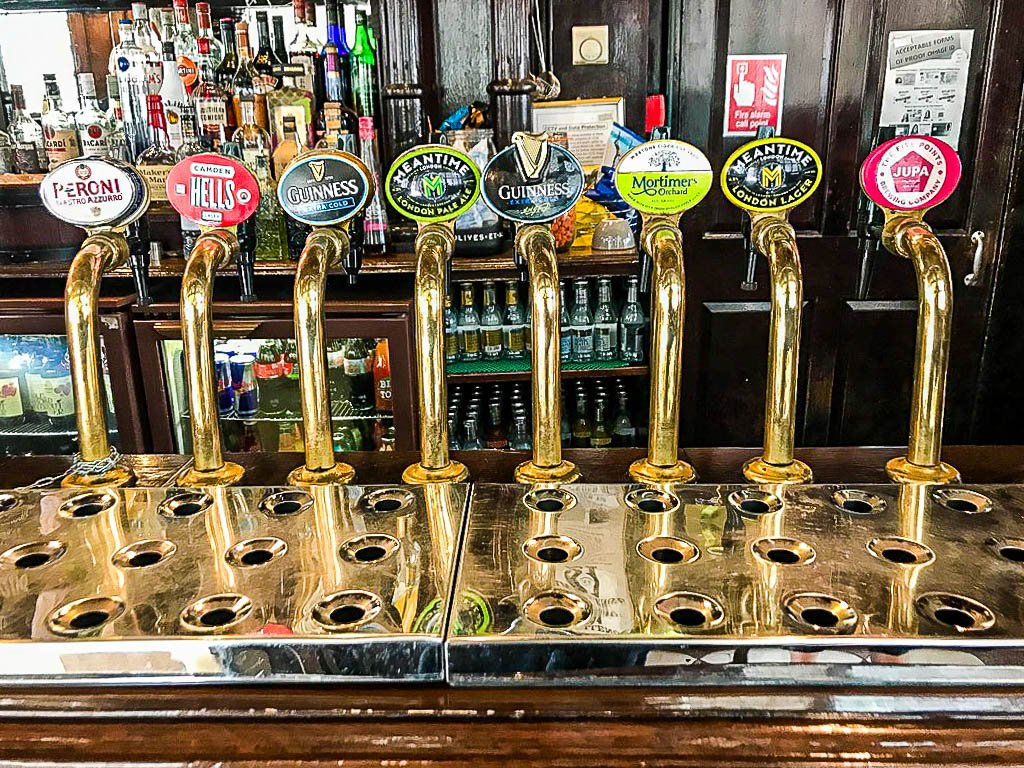
We have crawled all the following pubs which lie within five miles of the City of London, the historic financial district situated between the Temple Bar memorial pillar and the base of Tower Hill outside the iconic Tower of London fortress. The boundaries of this borough have changed little since the Middle Ages.
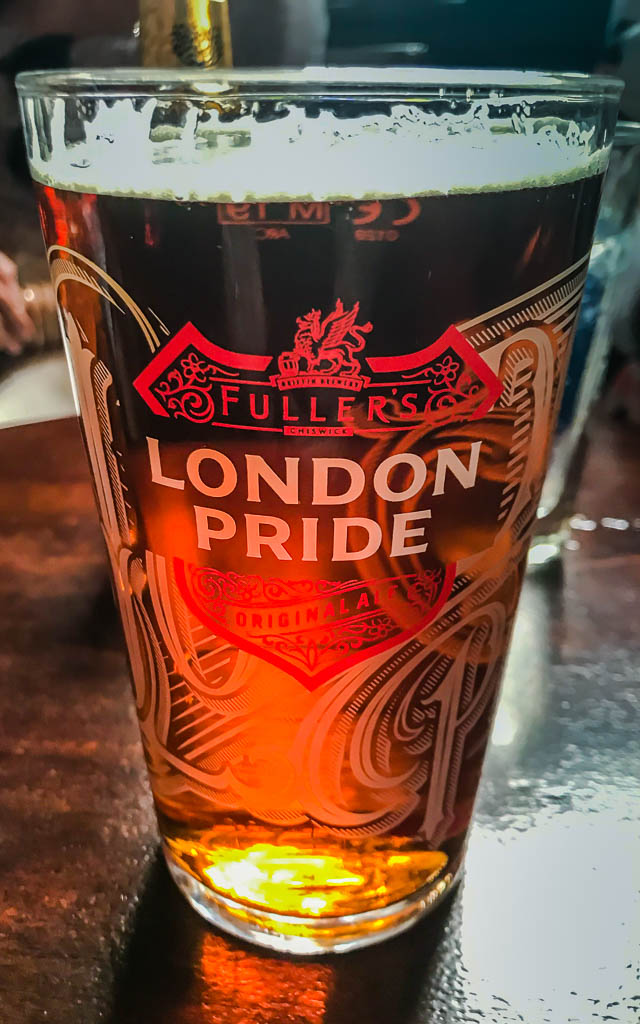
A pint of London Pride. Photo by Jett Britnell
THE COAL HOLE
“I turned Hamlet down because it was going to take up too much of my drinking time.”
—Richard Harris

Renowned for his unbridled drinking and unrestrained hellraising, especially with fellow mischievous thespians Richard Burton and Peter O’Toole, The Coal Hole was a regular haunt of legendary Irish actor Richard Harris. Today’s pub occupies what was formerly the coal cellar for the Savoy Hotel where Harris had taken up permanent residence in his later years. The famous actor could often be found in this street-level bar ensconced in a chair behind the fruit machine that kept him out of view from passing tourists.
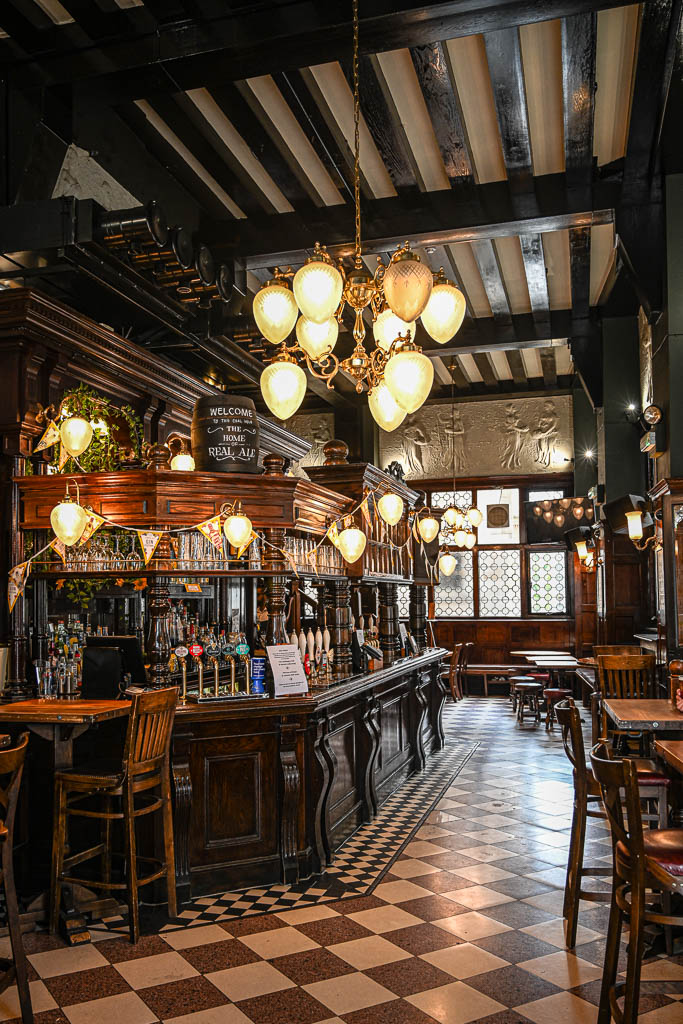
The Coal Hole bar near the front entrance. Photo by Jett Britnell
Back in the day, this Victorian pub was a “song and supper” club where patrons were encouraged to sing comical songs or sentimental ballads while titillating male diners with its statues of scantily clothed women in risqué poses. Musical duo Gilbert & Sullivan regularly performed hereafter rehearsals. In fact, on their opening nights at the Savoy, Gilbert would drive himself into a state of nervousness so intense that he could not linger in the theatre, so he would hastily retreat to this pub for some Dutch courage.
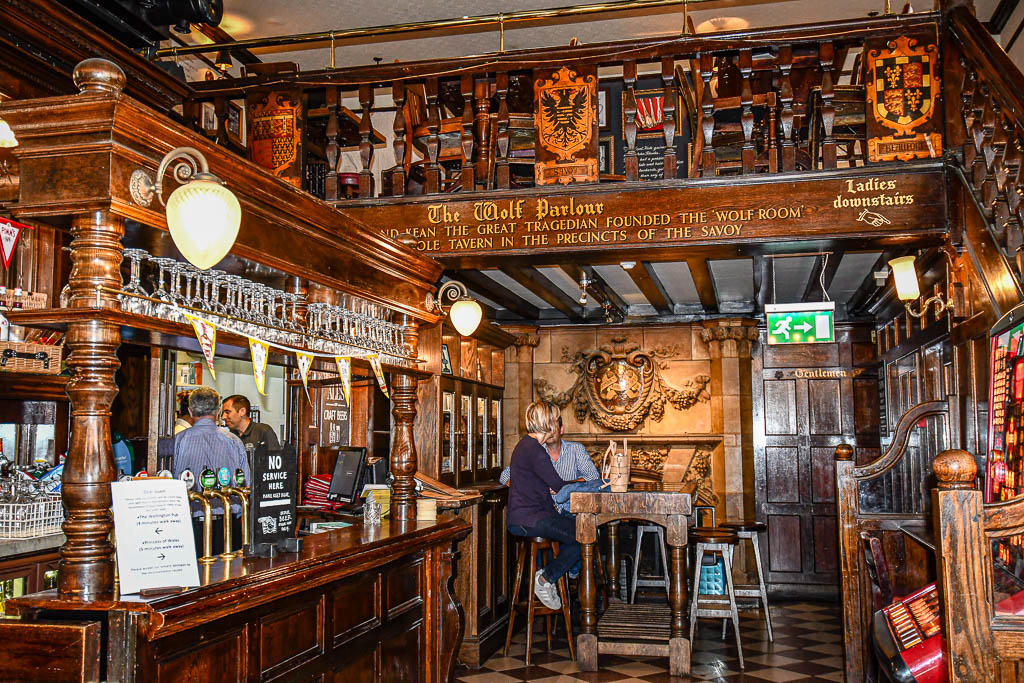
The back section of The Coal Hole. Photo by Kathryn Britnell
While the supper club has long been lost to time, The Coal Hole retains its original tile floors, large fireplace decorated with a relief of vines, dark wooden interior, leaded windows, and Art Nouveau adornments such as the marble frieze of maidens picking grapes. This fine tavern oozes old-world ambience and has an earned reputation for maintaining a selection of real ales. A fun venue to hoist a glass as you never know when somebody famous may stop in for a pint.
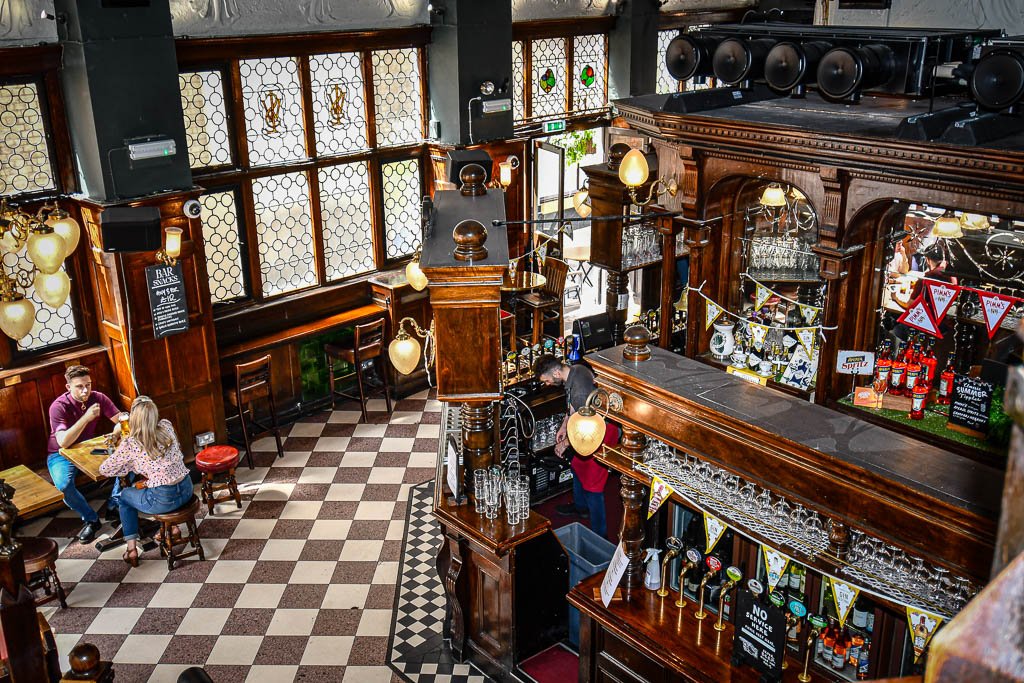
Established: 1903
Address: 91-92 Strand, Greater, London WC2R 0DW
Website: The Coal Hole
THE OLD KINGS HEAD
“There is nothing better than standing at a bar, talking nonsense while sipping a pint of real ale. Give me a pub rather than a fancy wine bar or a nightclub any day.”
— Tony Hadley
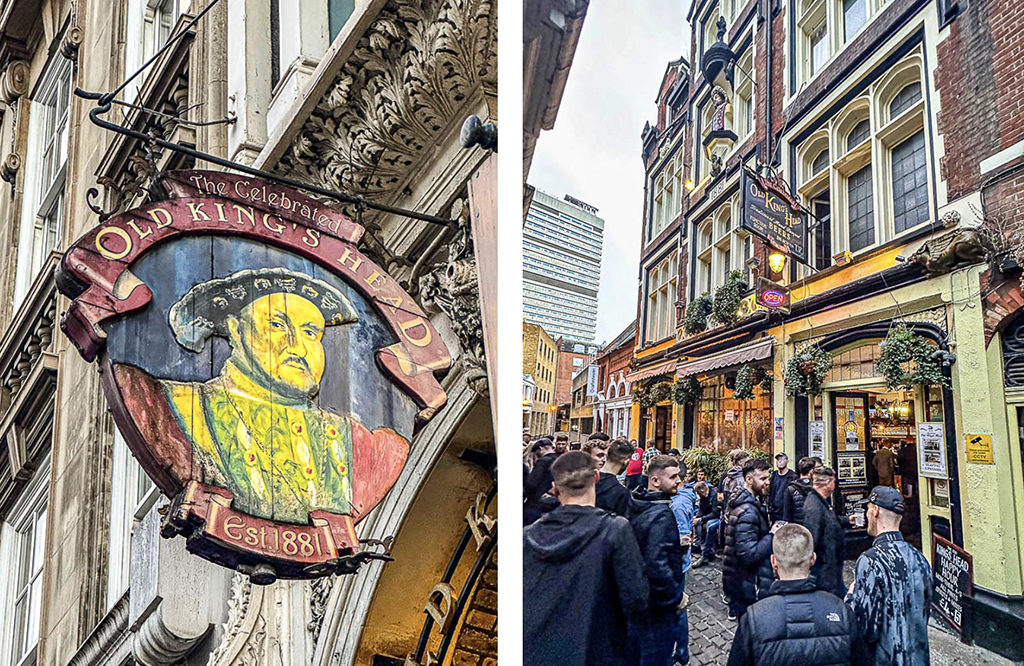
Outside The Old Kings Head pub. Photo by Jett Britnell
A short distance from the London Bridge tube station, down a narrow, cobblestone alleyway, you will likely find a crowd of pub patrons having a pint while standing outside The Old King’s Head. The pub bills itself as being, “A good old-fashioned pub with a warm friendly atmosphere.” A mid-size TV hanging on a wall was tuned to a soccer game when we entered. The place was filled to the rafters with male soccer fans who seemed to clear out for home as soon as the game ended. Well, after all, it was a school night. The King Head’s etched stained-glass windows hinted that this good old-fashioned bar had seen better days. We had a fine laugh talking to the local soccer fans who made us visitors from across the pond quite welcome by inviting us to join them at their table as the pub was crowded. Just beyond the bar, there is a stairway which ascends to a meeting room that boasts a collection of RMS Titanic memorabilia.
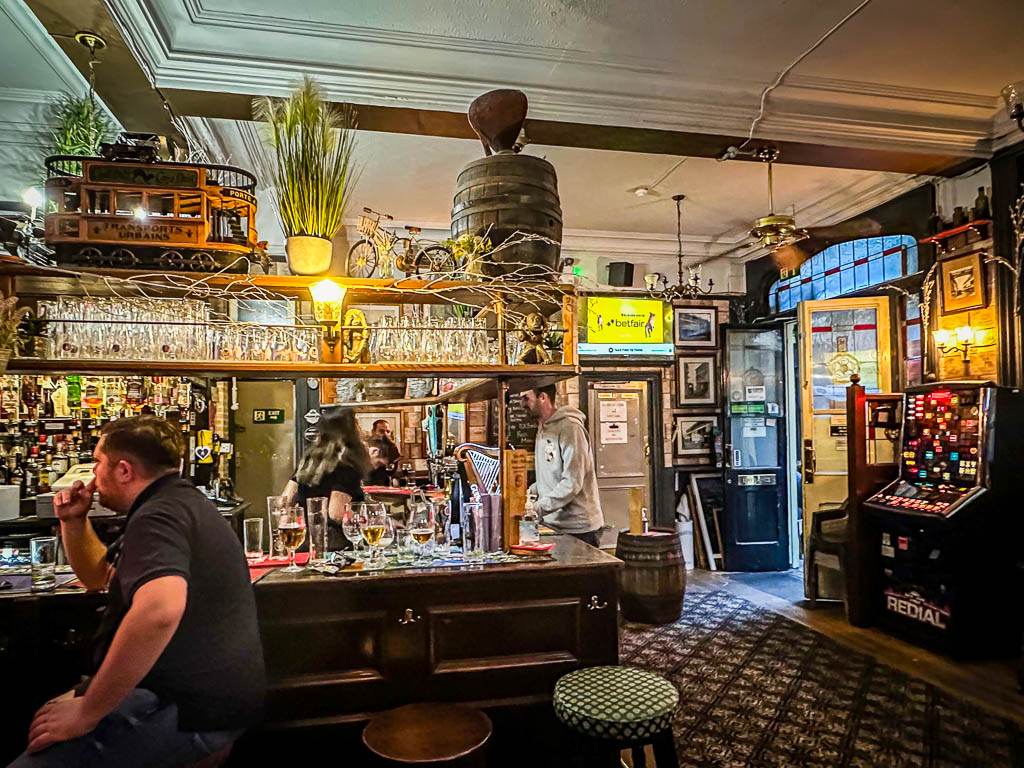
Interior of The Old Kings Head Pub. Photo by Jett Britnell
Established: 1881
Locations: 45-49 Borough High Street, London, SE1 1NA
Website: The Old Kings Head
THE CHURCHILL ARMS
“Everyone who enters this place makes us happy. Some when they arrive. Some when they leave”
— English Pub Quote
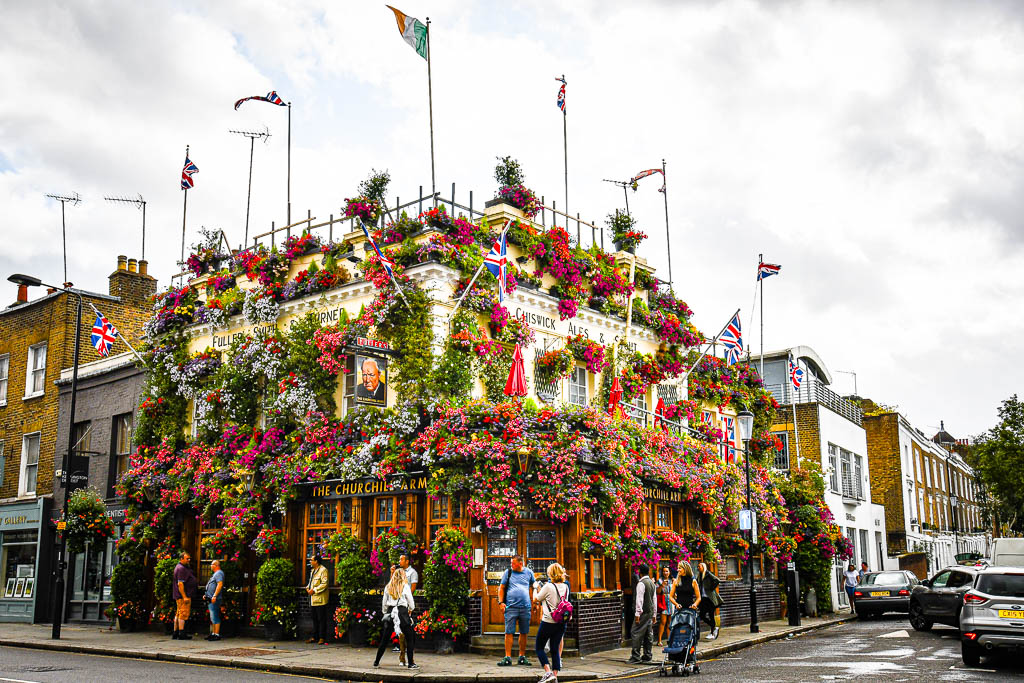
The eccentrically decorated Churchill Arms. Photo by Kathryn Britnell
Eccentrically decorated with exterior floral arrangements, this traditional pub which is just a few blocks away from Kensington Palace, was so named after WWII because it was regularly frequented by British Prime Minister Sir Winston Churchill’s grandparents, the 7th Duke of Marlborough and Lady Frances Anne Emily Vane. Previously known as the “Church on the Hill”, the interior of the pub is mot-surprisingly crammed with an extensive collection of Winston Churchill memorabilia along with other quirky from floor to ceiling décor. Strangely, this pub enough renowned for serving authentic Thai cuisine in its restaurant.
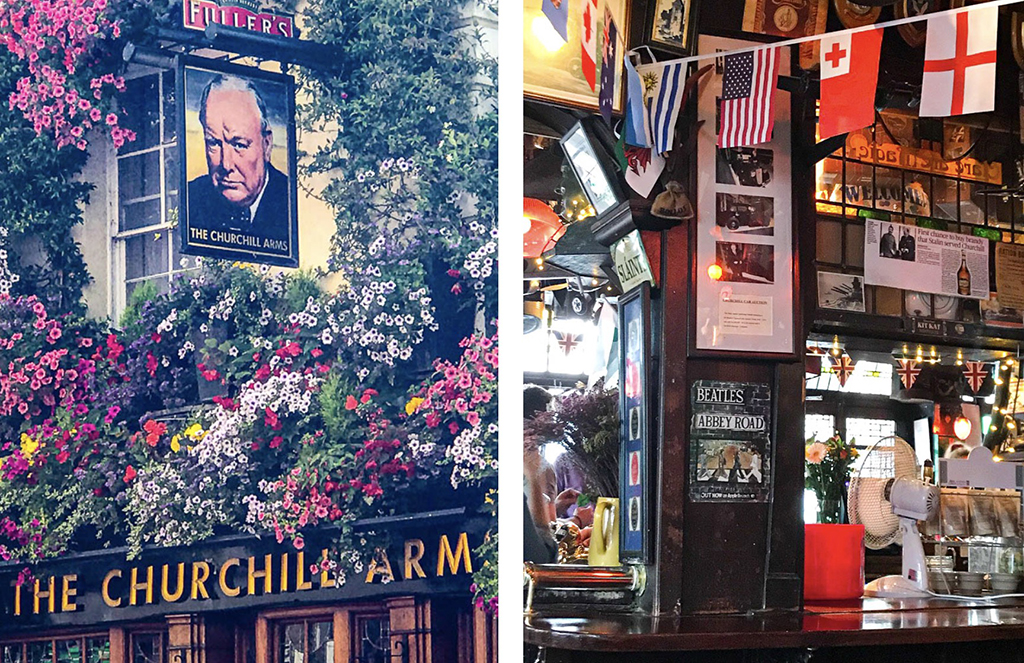
The Churchill Arms pub sign along with assorted memorabilia that adorns every nook and cranny of this pub. Photos by Jett Britnell
Established: 1750
Location: 119 Kensington Church St, London W8 7LN
Website: The Churchill Arms
HOOPS & GRAPES
“I have been pulling down houses, but the fire overtakes us faster.”
— Lord Mayor, on the Great London Fire of 1666
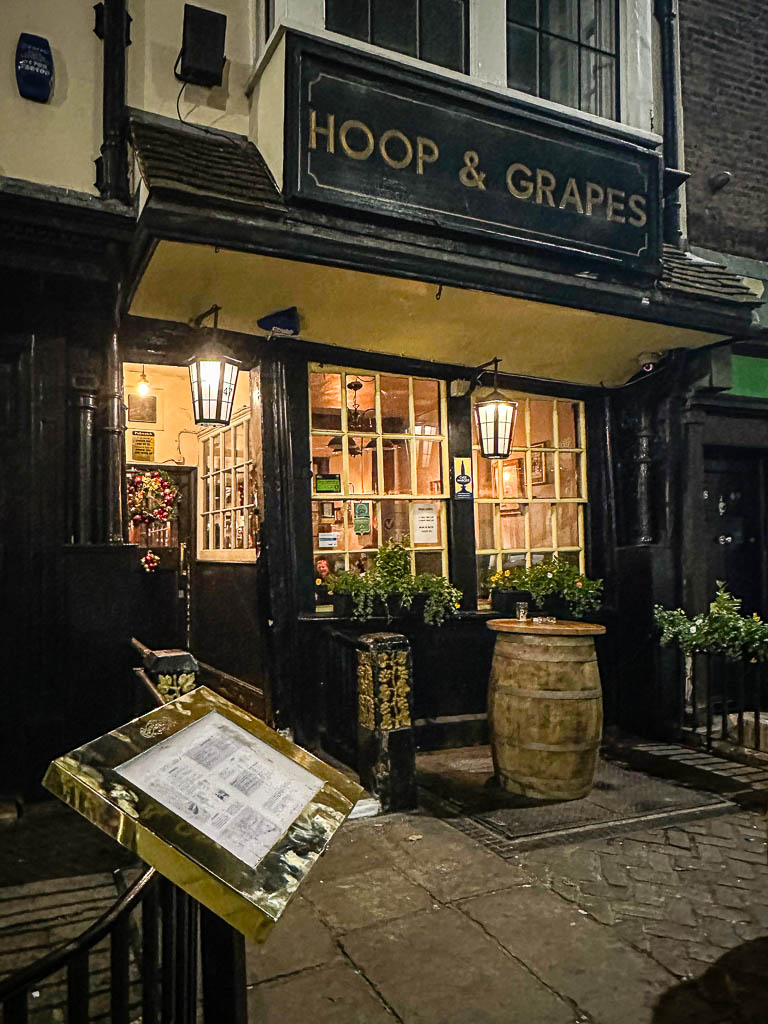
Hoop and Grapes is the oldest licensed house in the City of London. Photo by Jett Britnell
Hoop and Grapes is the oldest licensed house in the City of London, and one of the few Tudor timber buildings left unscathed after the Great Fire of 1666. It’s said the flames stopped only fifty yards from the front door of what was then a private house, which later became a wine shop before being turned into a pub approximately 150 years ago. Originally named The Castle it has also been christened the Angel & Crown and Christopher Hills before Hoop & Grapes, in reference to the sale of both beer and wine back in the 1920s. Rumor has it the pub’s blocked cellar entrance leads to the Tower of London. We stopped by for a late-evening beer and snack and were not disappointed.
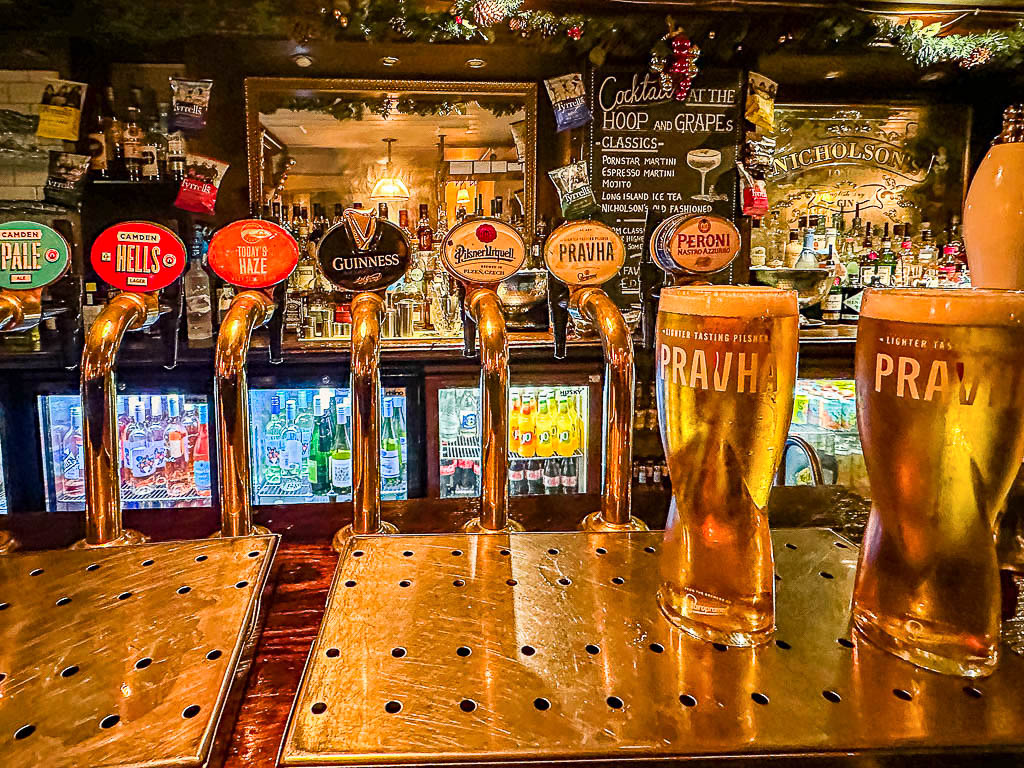
Hoops & Grapes bar taps. Photo by Jett Britnell
Established 1593
Location: 47 Aldgate High St, London EC3N 1AL
Website: Hoops & Grapes
PROSPECT OF WHITBY
“Give my people plenty of beer, good beer and cheap beer, and you will have no revolution among them.”
— Queen Victoria
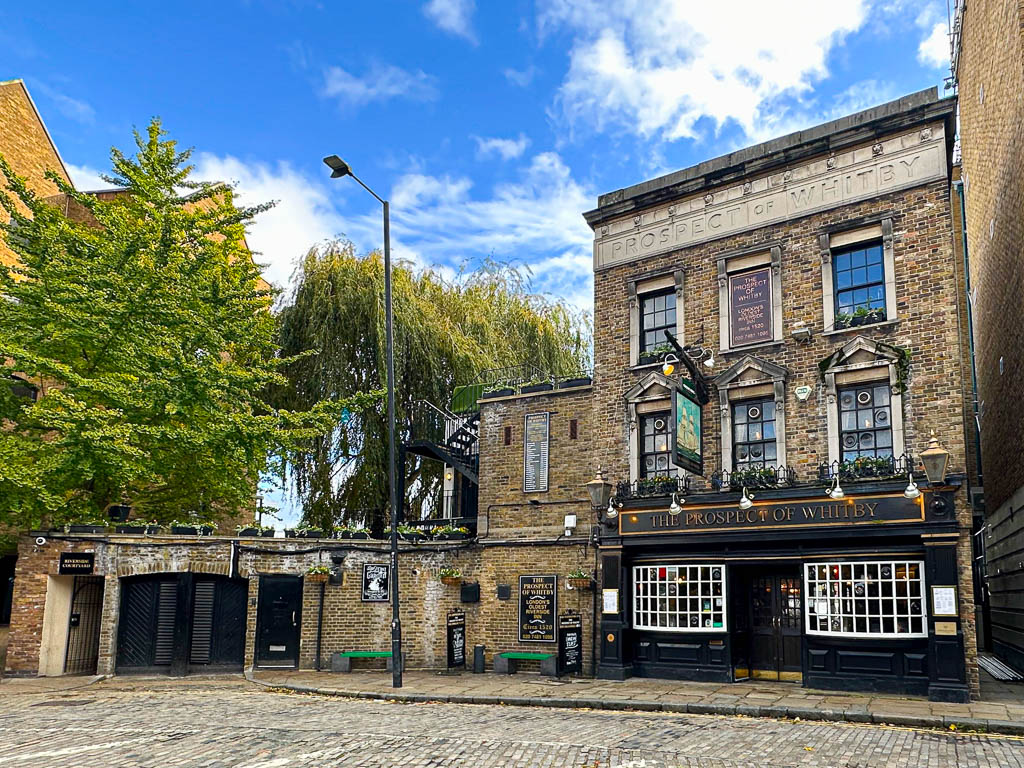
Prospect of Whitby. There has been a public house at this location since the time of Henry VIII. Photo by Jett Britnell
Claiming the title of being London’s oldest riverside pub, Prospect of Whitby is situated on the banks of the River Thames at Wapping in the London Borough of Tower Hamlets. There has been a public house at this location since the time of Henry VIII. The first public house on this site was an establishment of ill repute named “The Pelican.” Catering to unsavoury characters in the guise of smugglers, sea-rovers, river thieves, and pirates earned this hangout the hellish nickname the “Devil’s Tavern”, the joint indulged bare-knuckle fighting, the trading of contraband, and cockfighting. Any dead bodies that washed up from the river were sold. After the original tavern burnt down in the eighteenth century, it was rebuilt and the pub was renamed Prospect of Whitby after a collier ship called “The Prospect”, which regularly transported coal here from Whitby in Yorkshire. The pub’s owner wanted a name change to help put some distance between the tavern’s dark criminal past.
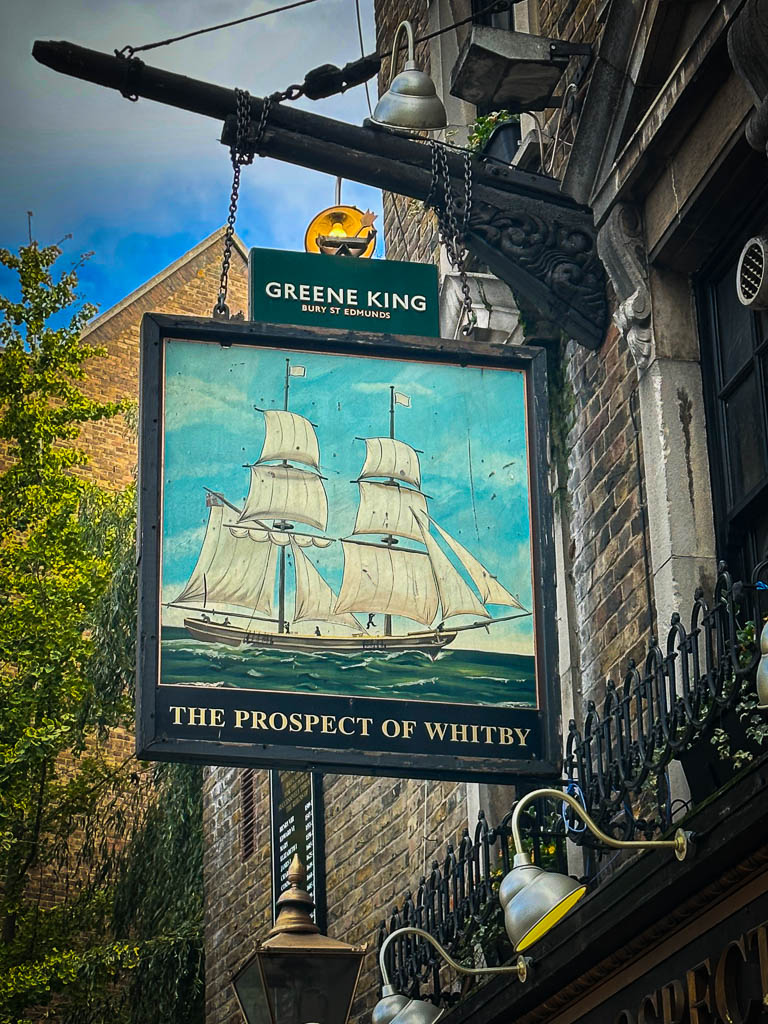
Prospect of Whitby pub sign. Photo by Jett Britnell
Today, what remains from the building’s swashbuckling past are a 400-year-old flagstone floor and a long pewter-topped bar. Nautical embellishments are scattered throughout this classic pub’s interior such as ship’s wheels, old barrels, Union Jack flags pinned to the ceiling and old timber pillars that appear to be from sections of a sailing ship’s masts. Offering lovely views of the Thames, The Prospect of Whitby offers an inviting British pub menu paired with a good selection of beer, wine, and gin. Some notable visitors down through the years include Charles Dickens, Captain Kidd, Princess Margaret, Samuel Pepys, JMW Turner, Prince Rainier III of Monaco, and Richard Burton. This was also the favorite pub of the notorious Judge Jeffreys, “the hanging judge” who would often stop in for a drink after a hard day’s work at the Execution Dock. Hence, the replica gallows with a swinging hangman’s noose by the pub’s Thames-side foreshore window.
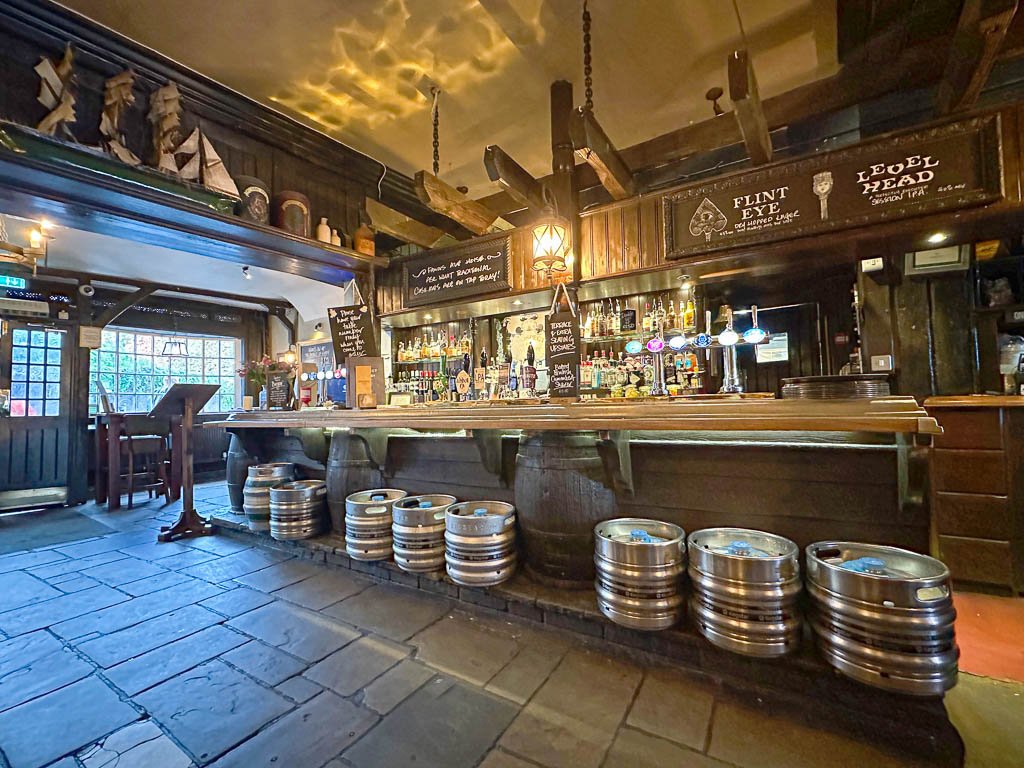
Today, what remains from the building’s swashbuckling past are a 400-year-old flagstone floor and a long pewter-topped bar. Photo by Jett Britnell
Established 1520
Location: 57 Wapping Wall, London E1W 3SH, UK
Website: Prospect of Whitby
YE OLDE WATLING
“He was a wise man who invented beer.”
— Plato
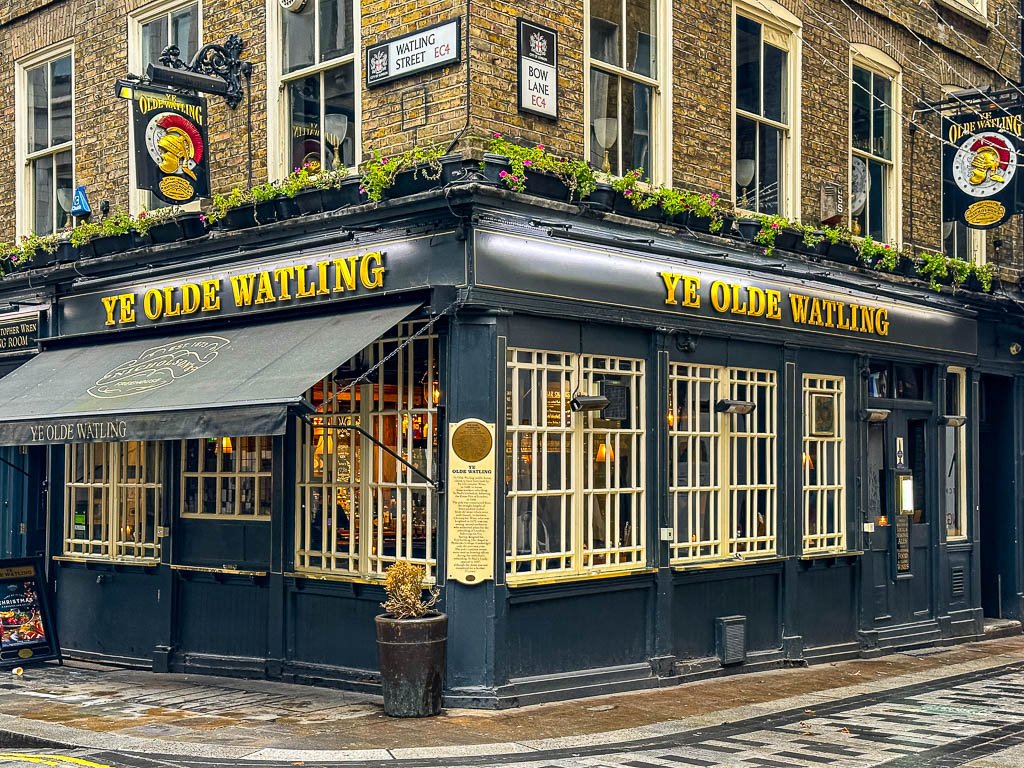
Ye Olde Watling is situated on one of Britain’s most famous Roman roads. Photo by Jett Britnell
Situated on one of Britain’s most famous Roman roads, Ye Olde Watling on Watling Street, within easy walking distance from the iconic St Paul’s Cathedral. Constructed from brine-soaked black timbers repurposed from 17th-century sailing ships is said to have been built by Sir Christopher Wren, one of the most highly acclaimed English architects in history. Wren ceased building work on St Paul’s Cathedral long enough to construct this pub to provide accommodations for the men working on the cathedral project, with the inn’s upstairs rooms being used as the drawing offices. As you would expect from an establishment with such noble linage, the interior is a cozy oasis in the heart of London’s concrete jungle.
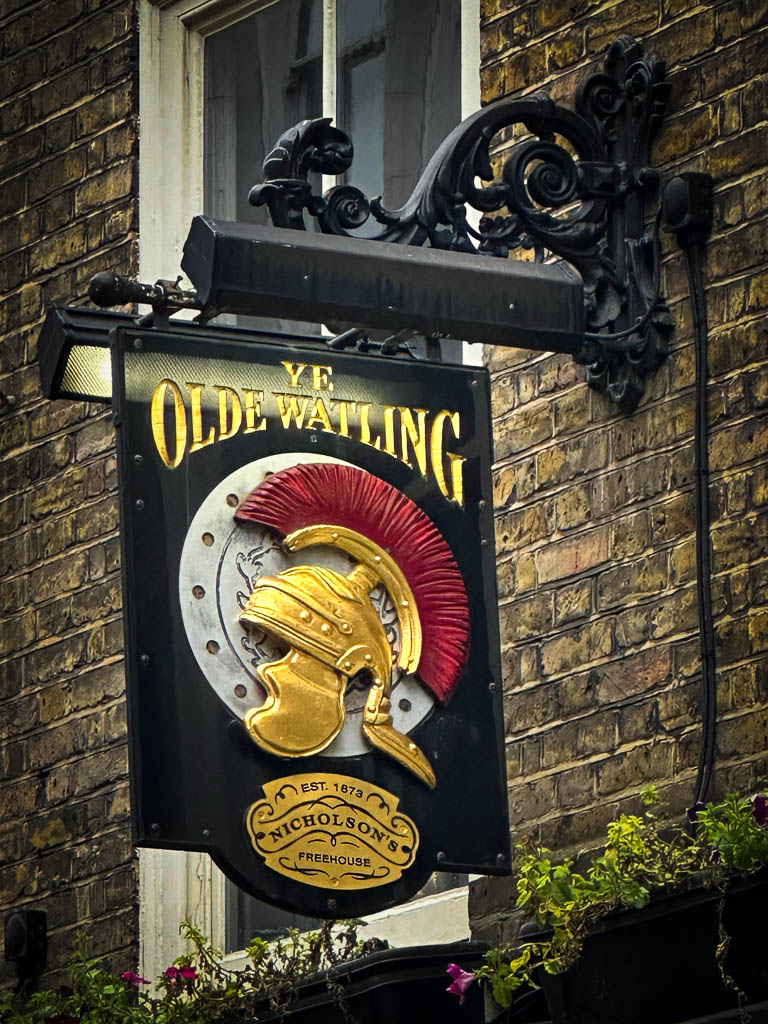
Ye Olde Watling pub sign. Photo by Jett Britnell
Established 1668
Location: 29 Watling Street, EC4M 9BR
Website: Ye Olde Watling
THE VIADUCT TAVERN
“There’s just two of us down here now”
— Fred (The Viaduct’s resident ghost)

Hailed as being one of the City of London’s most beautiful boozers, The Viaduct Tavern is one of the last standing examples of a former Victorian Gin Palace. Elaborately fitted with dark mahogany décor, this pub has Renaissance-style art adorning its walls and exquisitely ornate ceilings. This watering hole is also touted as being “the most haunted pub in London.” A highlight of ghost walking tours, The Viaduct is rather ominously situated opposite the infamous Old Bailey courthouse, a place where between 1730 and 1837, 9,481 men, women and children were sentenced to death for minor property offences such as stealing a handkerchief or a sheep. Thousands of hangings took place across the street where a fountain now stands.
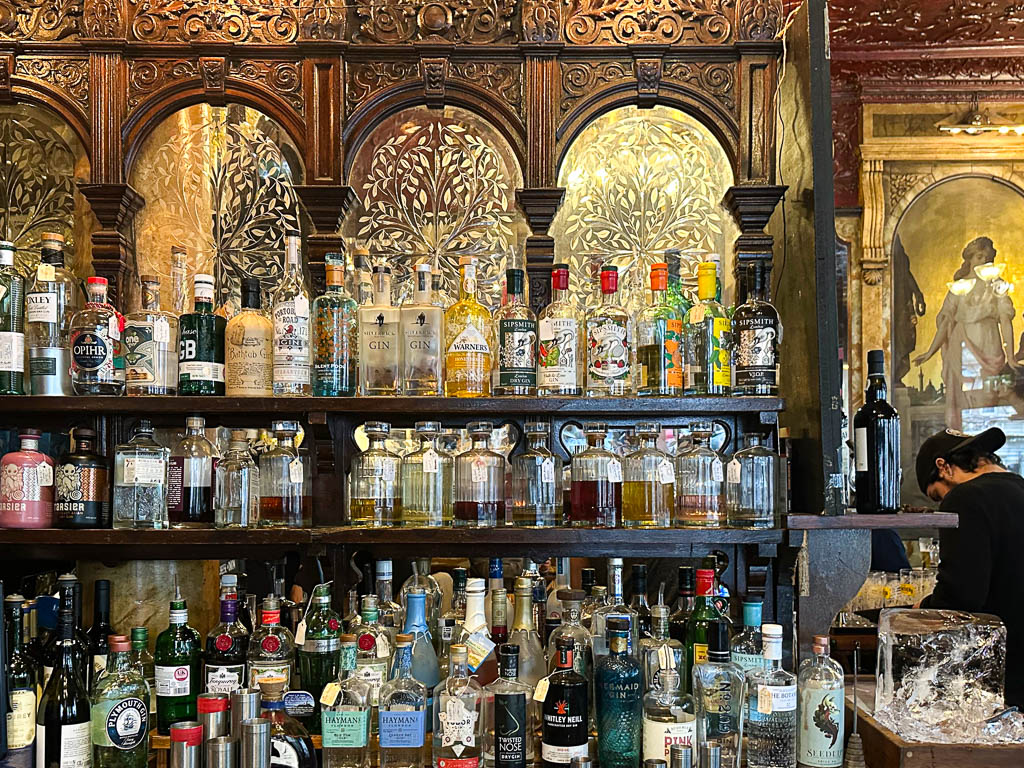
The Viaduct Taverns gin selections. Photo by Jett Britnell
One of the most alarming stories of paranormal activity occurred when a former landlord was alone in the basement’s ancient beer and coal cellars one evening. Suddenly, all the lights went out and the door behind him slammed shut. A voice whispered to the landlord, “There’s just two of us down here now”. The terrorized landlord was reportedly rescued by his wife after she heard his screams for help. Along with this story of the supernatural, both the tavern’s ground and upper floors have reports of poltergeist activity with objects being thrown or people being touched. In the men’s restroom there is a warning sign that says if the hand dryer spontaneously goes on, it is just their friendly ghost, Fred, saying hello. Whether these ghost stories here are true, or not, The Viaduct Tavern is a great place to visit.
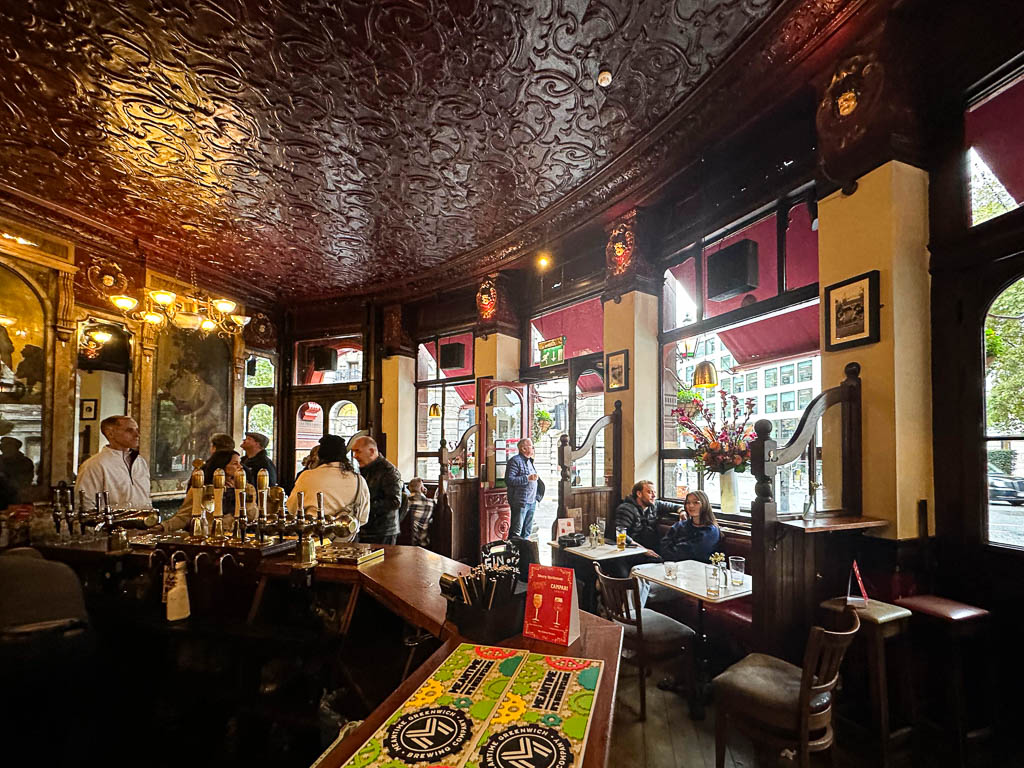
The Viaduct Tavern’s interior. Photo by Jett Britnell
Established: 1865
Location: 126 Newgate Street, London EC1A 7AA
Website: The Viaduct Tavern
THE SALISBURY PUB
“In the end, in England, when you want to find out how people are feeling, you always go to the pubs.”
— Martha Gelhorn
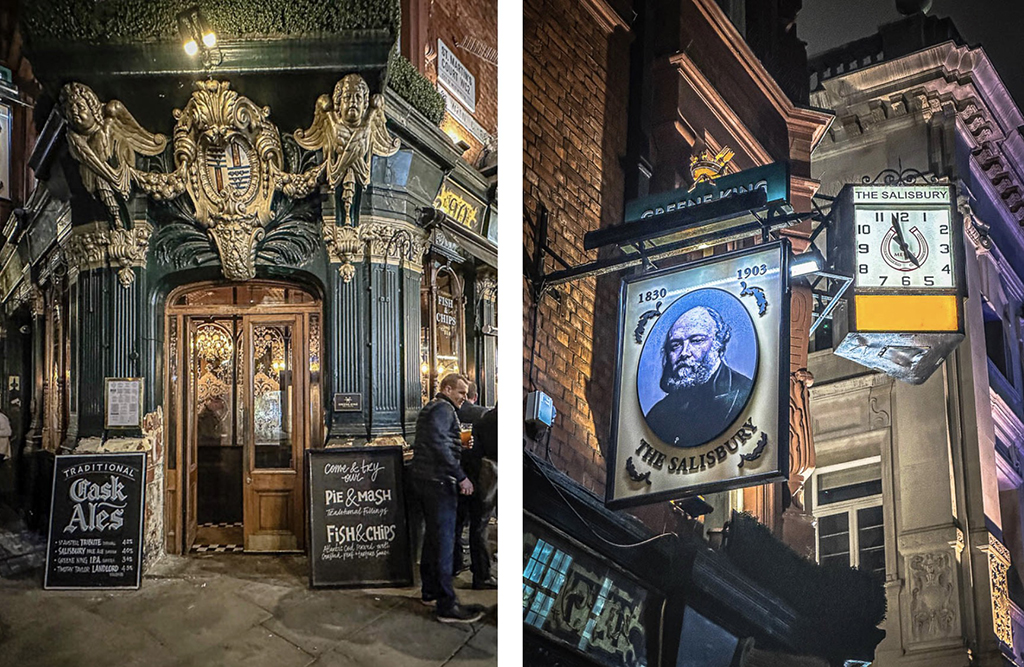
The opulent Salisbury pub. Photo by Jett Britnell
Perhaps London’s most opulent Victorian-era pub with its magnificent marble bar, richly upholstered semicircular banquettes, carved mahogany, Art Nouveau light fittings, and etched and polished glass, this infamous Victorian drinking hole on St Martin’s Lane in Covent Garden’s theater district takes its name from the Marquess of Salisbury, a three times Prime Minister between the years 1885 and 1902. His likeness adorns the pub’s sign. From Oscar Wilde’s time up until the mid-1980s, the Salisbury was well-known as a gay-friendly pub. The place can become crowded before curtain-up at the nearby theaters. There’s no denying this pub’s exalted atmosphere and palpable ghosts of thespians’ past vibe. Not surprisingly, this ornate venue has been featured in several films.
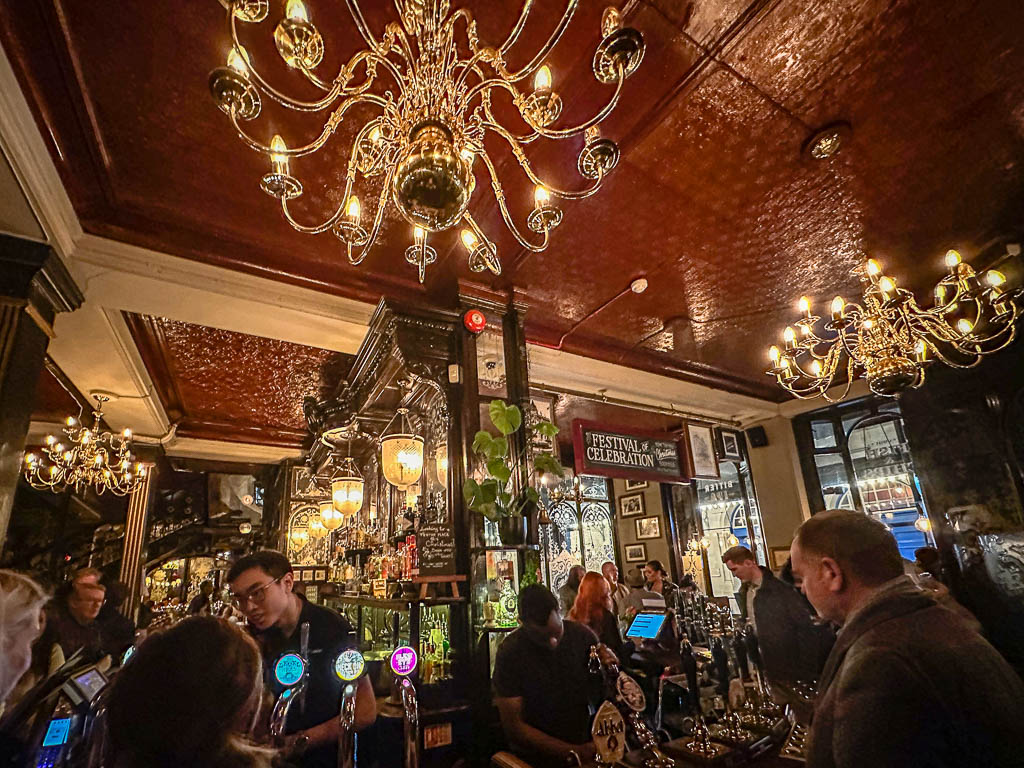
The Salisbury pub interior. Photo by Jett Britnell
Back in the 50’s and 60’s Salisbury reached the apogee of its popularity when it catered to an enviable list of celebrities such as Robert Moore, Albert Finney, Terence Stamp, Richard Burton, Michael Caine, Robert Shaw, Ronald Fraser, Oliver Reed, Keith Waterhouse, Sean Connery, Laurence Harvey, Kenneth Griffith, Trevor Howard, Richard Attenborough, Marianne Faithfull, Clint Eastwood, Robert Mitchum, Peter Finch, Lee Marvin, plus others. When Peter O’Toole made his glorious return to London in 1962 after starring in the British epic film, Lawrence of Arabia, he swept into the Salisbury with its mirrored walls, wearing his sartorial Lawrence Bedouin costume for a laugh. O’Toole bellowed, “I’m home from the desert, dears!” to which fellow actor and boozer, Johnny Briggs, who went on to play Mike Baldwin in the long-running British soap opera Coronation Street, replied. “Never mind the desert, have you got your bloody handbag so you can buy the beers?”
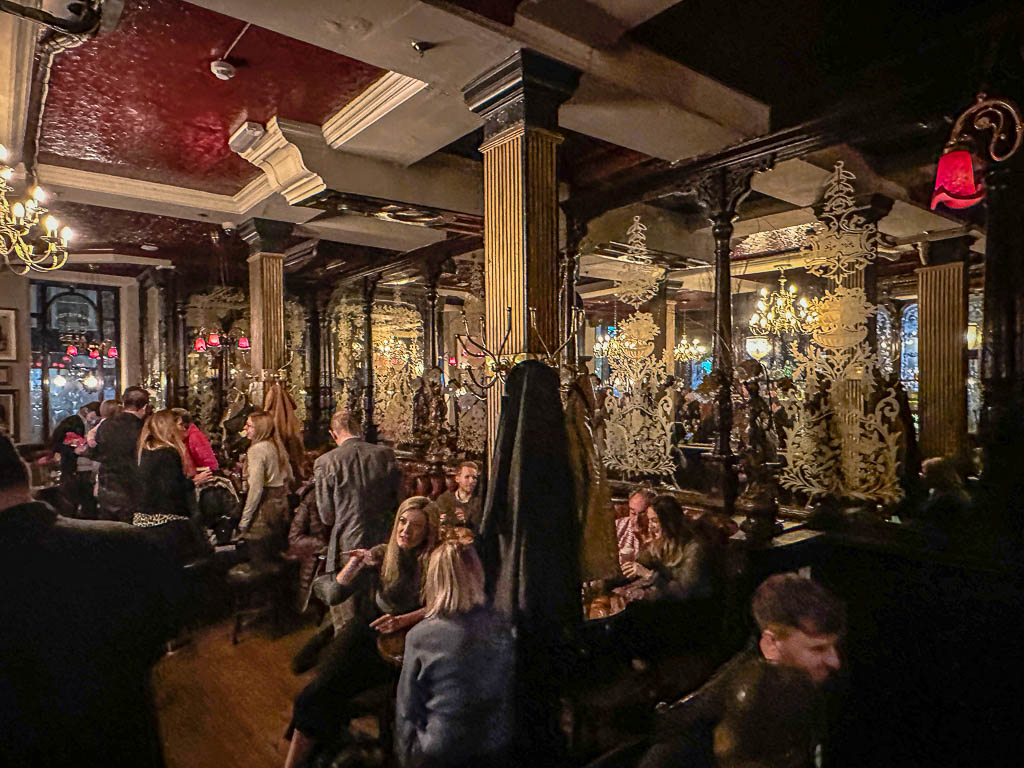
Established: 1898
Location: 90 St. Martin’s Lane, Charing Cross, London WC2N 4AP
Website: The Salisbury Pub
YE OLDE COCK TAVERN
“There is nothing which has yet been contrived by man, by which so much happiness is produced as by a good tavern.”
— Samuel Johnson
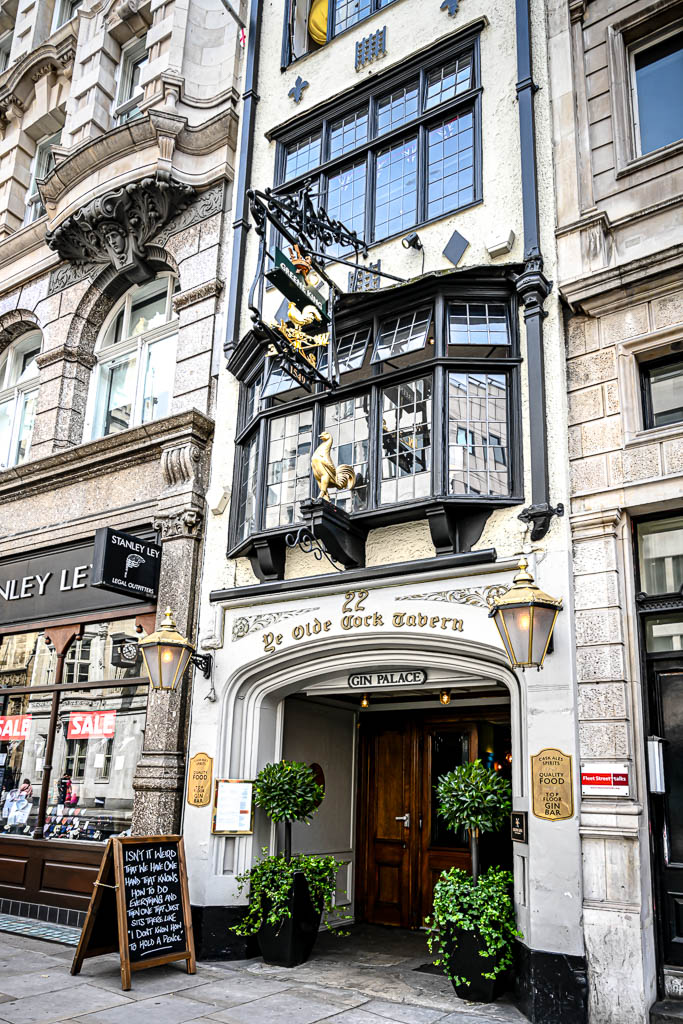
Ye Olde Cock Tavern. Photo by Jett Britnell.jpg
Heralded as being the narrowest pub within the City of London, this place is not old as it looks. Originally, the Ye Olde Cock Tavern was situated in Apollo Court just across the road. To make way for the opening of a new Bank of England branch, the 16th-century tavern moved to the opposite side of Fleet Street to its present location in 1887. Among the famous writers who drank and ate here are Charles Dickens, Samuel Johnson, and Lord Tennyson. The world’s oldest “free speech” forum the Society of Cogers, founded in 1755, also holds its monthly meetings at Ye Olde Cock.
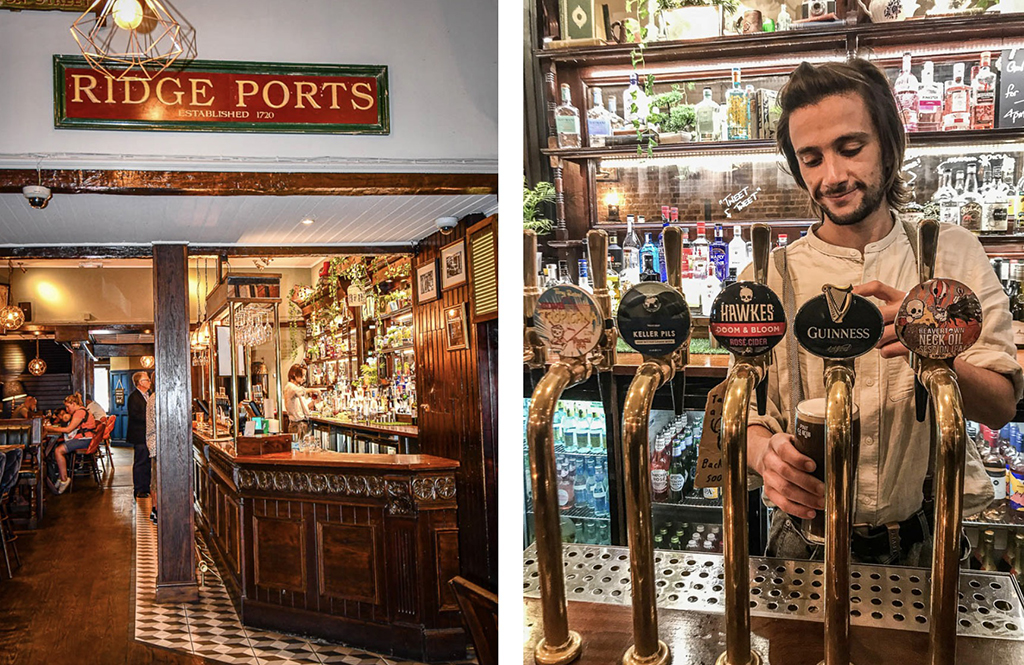
Ye Olde Cock Tavern bar – Photos by Kathryn & Jett Britnell
The interior of this tavern is indeed quite narrow and has a more modern appearance than most pubs of this age. Exposed brick walls, and leatherette banquettes, mixed with low lighting combine to create an inviting ambiance that oozes character. All in all, a relaxing watering hole with a welcoming atmosphere and a well-stocked bar.
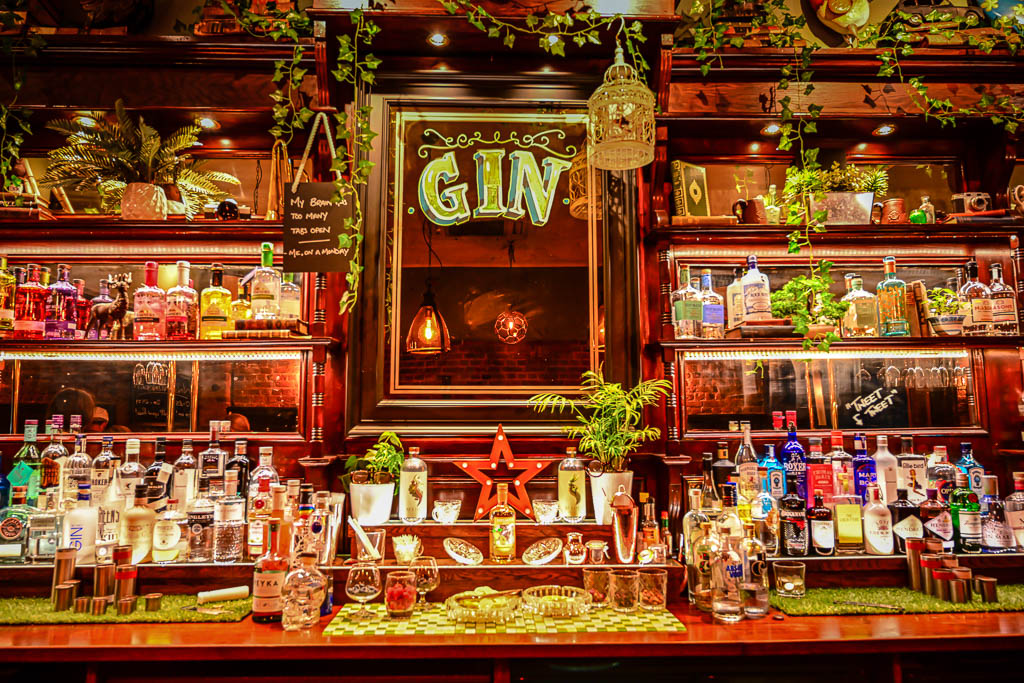
Ye Olde Cock Tavern’s bar. Photo by Jett Britnell
Established 1549
Location: 22 Fleet Street EC4Y 1AA
Website: Ye Olde Cock Tavern
THE MAYFLOWER PUB
“Humankind was built on beer. From the world’s first writing to its first laws, in rituals social, religious, and political, civilization is soaked in beer.”
— William Bostwick
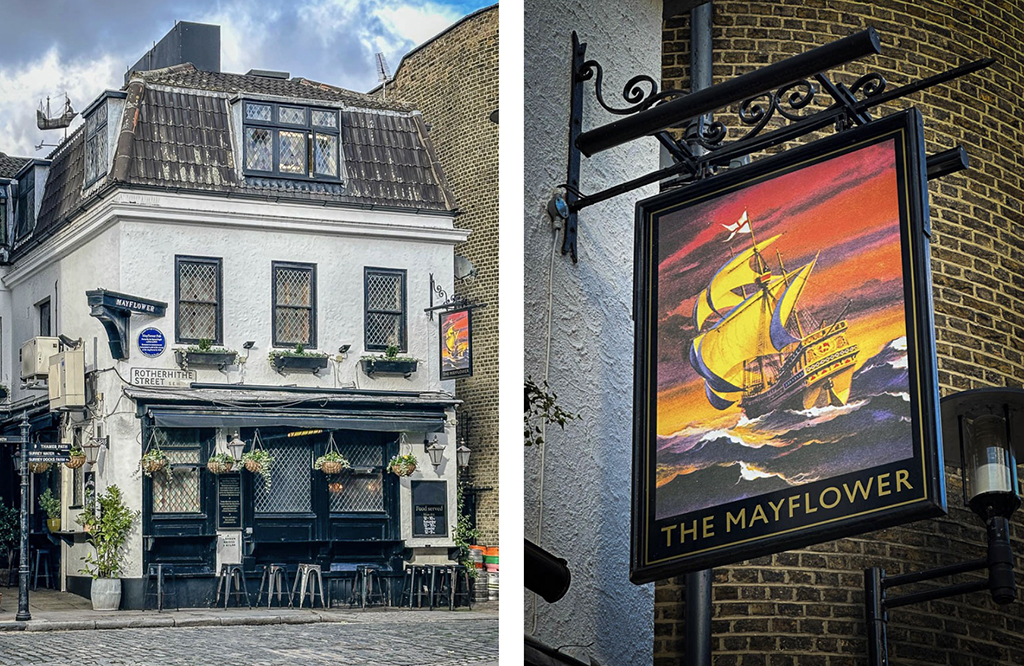
The Mayflower pub. Photo by Jett Britnell
The Mayflower Pub on the River Thames at Rotherhithe was named after the famous ship whose original mooring point was next door before it embarked to Southampton before sailing off to the New World in 1620. There is a wall plaque inside the nautical-themed Mayflower that reads, “This restored 16th-century public house was originally called the Spread Eagle. It is named after the ship chartered by the pilgrim fathers, who left Rotherhithe for America in 1620.” While a public house has continuously stood on this riverside location since 1550, the current building was rebuilt as the Spread Eagle in 1780 being renamed The Mayflower in 1957.
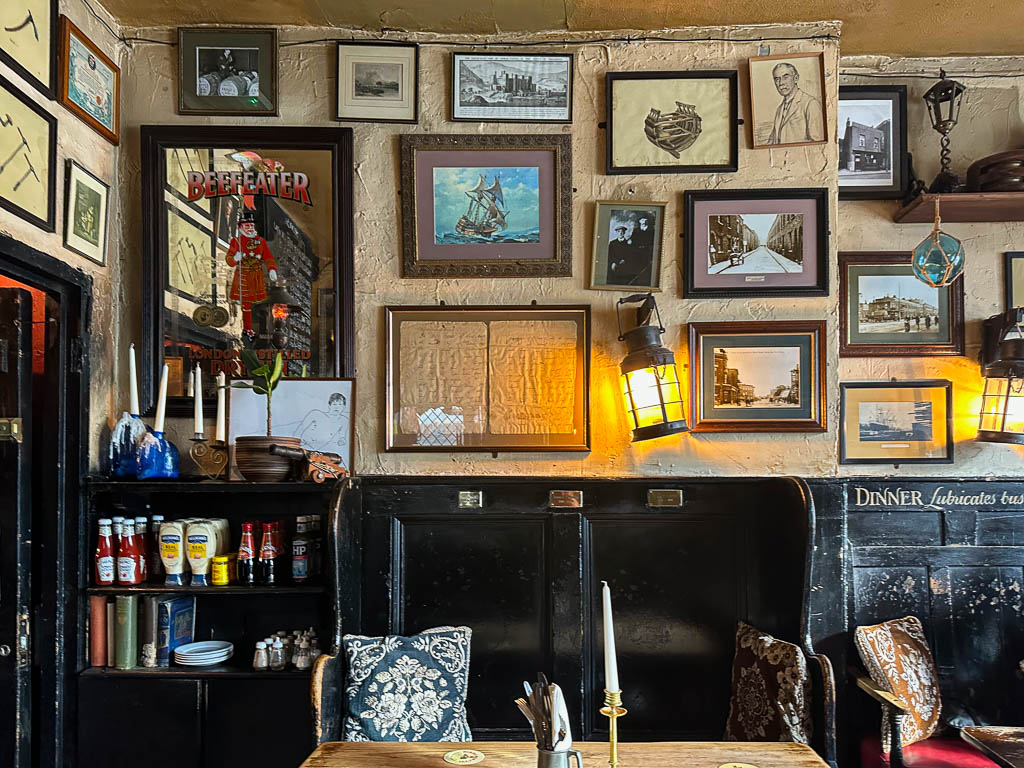
If the creaky floors, and old oak beams, amidst this Rotherhithe boozer’s ecclesiastical wooden pews, could talk, what a tale to tell. The pub’s nautical history is reflected in the seafaring memorabilia gilding the low ceilings and sideboards. A model of the Mayflower ship sits above the bar alongside an eclectic collection of antiques and witty signs. Ignore the taxidermy trimmings adorning some walls. Ornate French doors in the back open to an outdoor wooden deck that overlooks the Thames and provides a scenic view of London Bridge. A throwback to this pub’s past life serving seafarers, The Mayflower holds the unique distinction of being the only pub licensed to sell US and UK postage stamps at the bar.
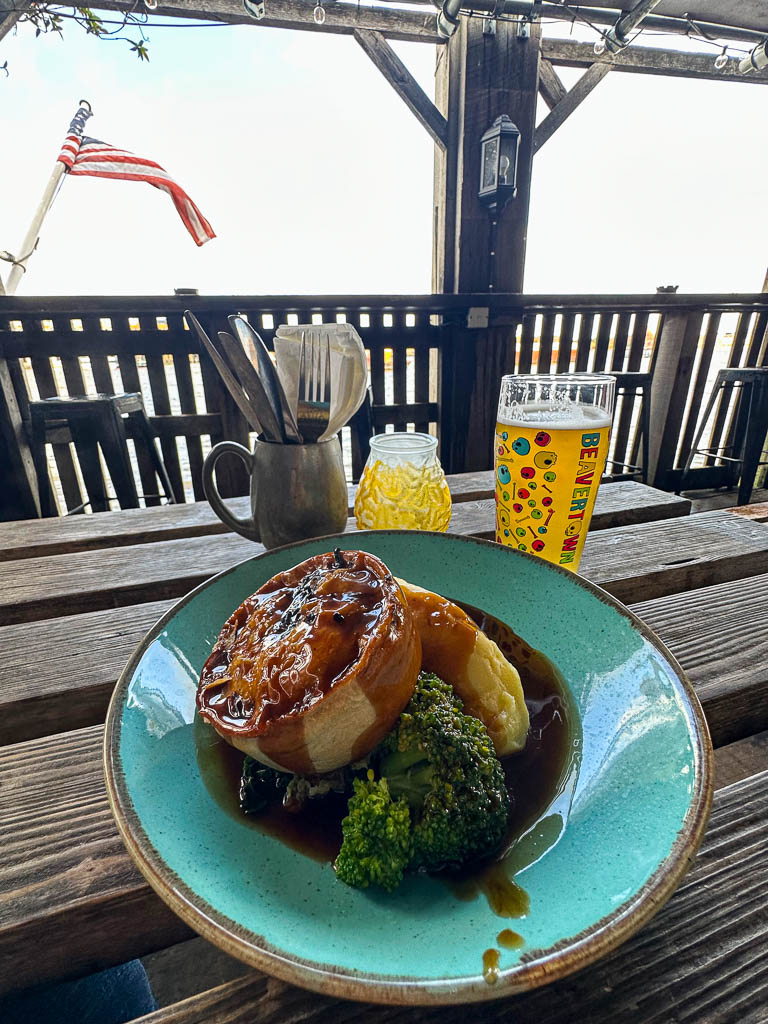
A pub lunch on the river deck at The Mayflower. Photo by Jett Britnell
Apart from the claim they serve the best fish and chips in London, consuming a pint here is akin to taking a step back in time to 16th-century London. If you can prove that you’re a descendant of one of the Mayflower passengers or crew, you’re invited to sign the pub’s treasured guestbook.
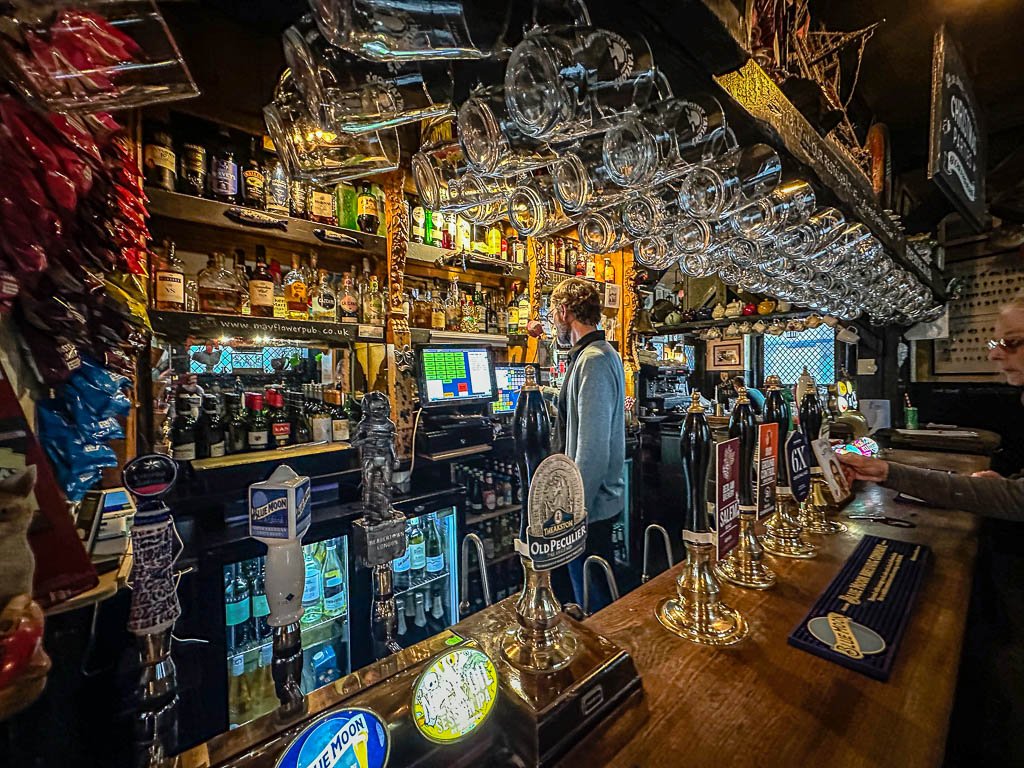
Established 1550
Location: 117 Rotherhithe Street, Rotherhithe, SE16 4NF
Website: The Mayflower
YE OLDE CHESHIRE CHEESE
“A good local pub has much in common with a church, except that a pub is warmer, and there’s more conversation.”
— William Blake
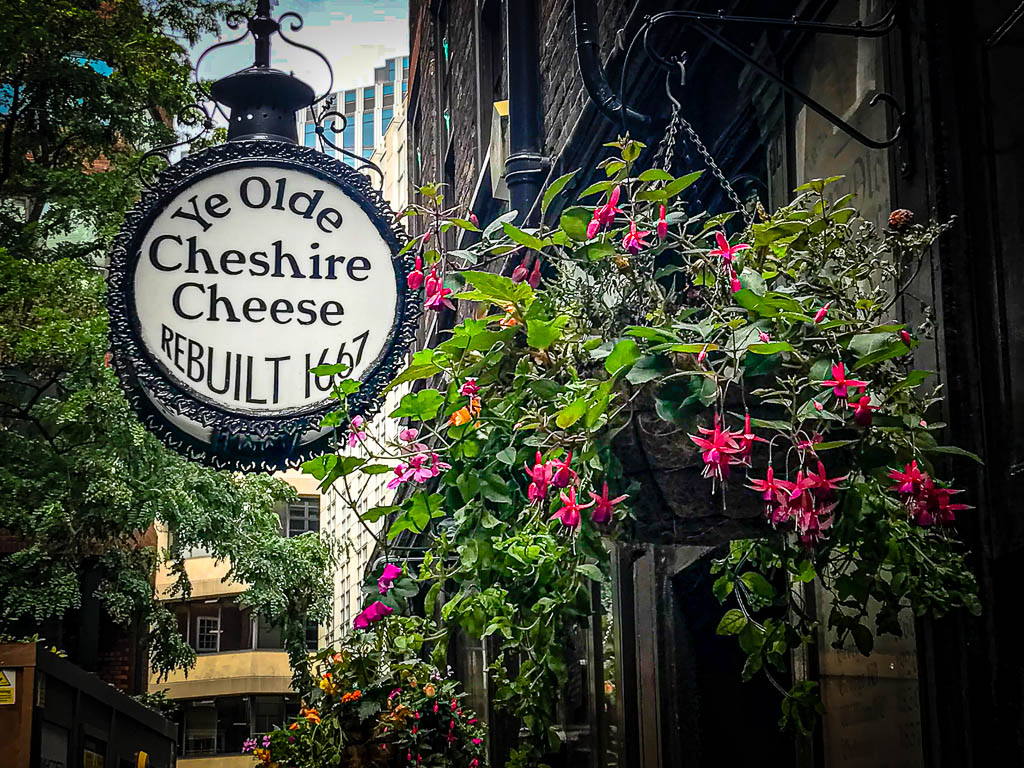
Ye Olde Cheshire Cheese pub. Photo by Jett Britnell
A centuries-old Fleet Street public house, Ye Olde Cheshire Cheese has been an author’s hangout for some of the world’s most distinguished literary figures. Oscar Wilde, W.B. Yeats, Mark Twain, Sir Arthur Conan Doyle, Alfred Tennyson, George Orwell, P.G. Woodhouse, Ezra Pound, and Dr. Samuel Johnson have sought nourishment within its walls. Dickens alluded to this watering hole in his tome A Tale of Two Cities. A London institution since 1538, the pub was rebuilt here shortly after the Great Fire of 1666. Apparently, in 1538 another pub stood here called The Horn Tavern and the building’s cellar is what remains from a 13th-century Carmelite monastery. The newly rebuilt pub was christened Ye Olde Cheshire Cheese in 1667.
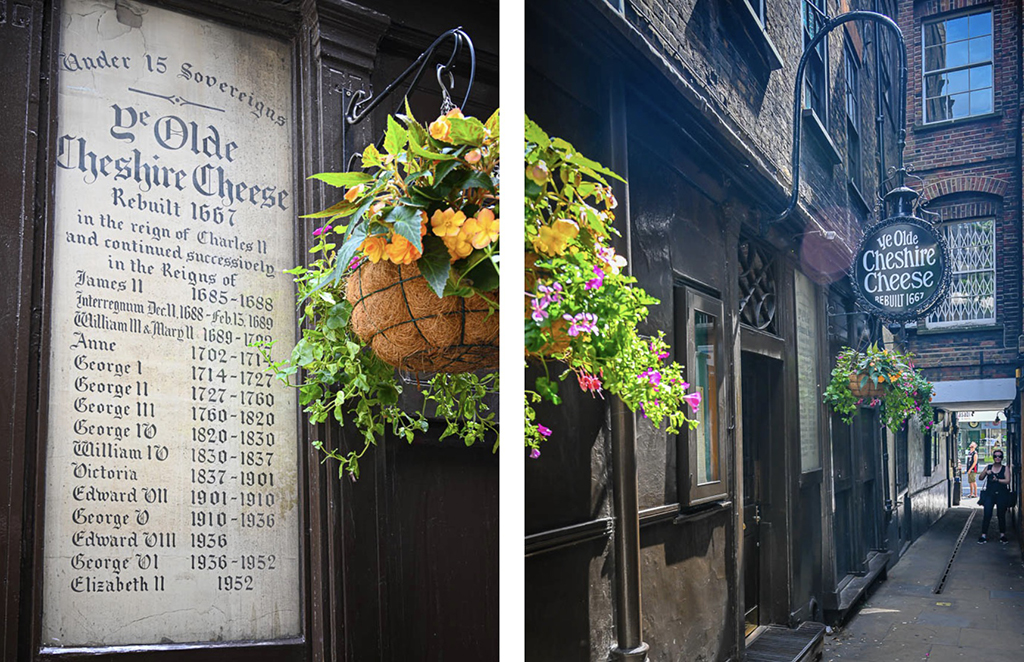
Ye Olde Cheshire Cheese alley way entrance. Photos by Jett Britnell
A sign above the doorway reads, “Gentlemen only served in this bar.” A throwback to a bygone era as this rule no longer applies. It’s easy to become lost within this legendary pub’s dark wood interior and narrow hallways as there’s no natural light inside. With a fine selection of traditional ales and British pub menu classics on the menu, coupled with its enviable list of historical literary greats who have frequented this watering hole, Ye Olde Cheshire Cheese seems destined to remain a Fleet Street landmark.
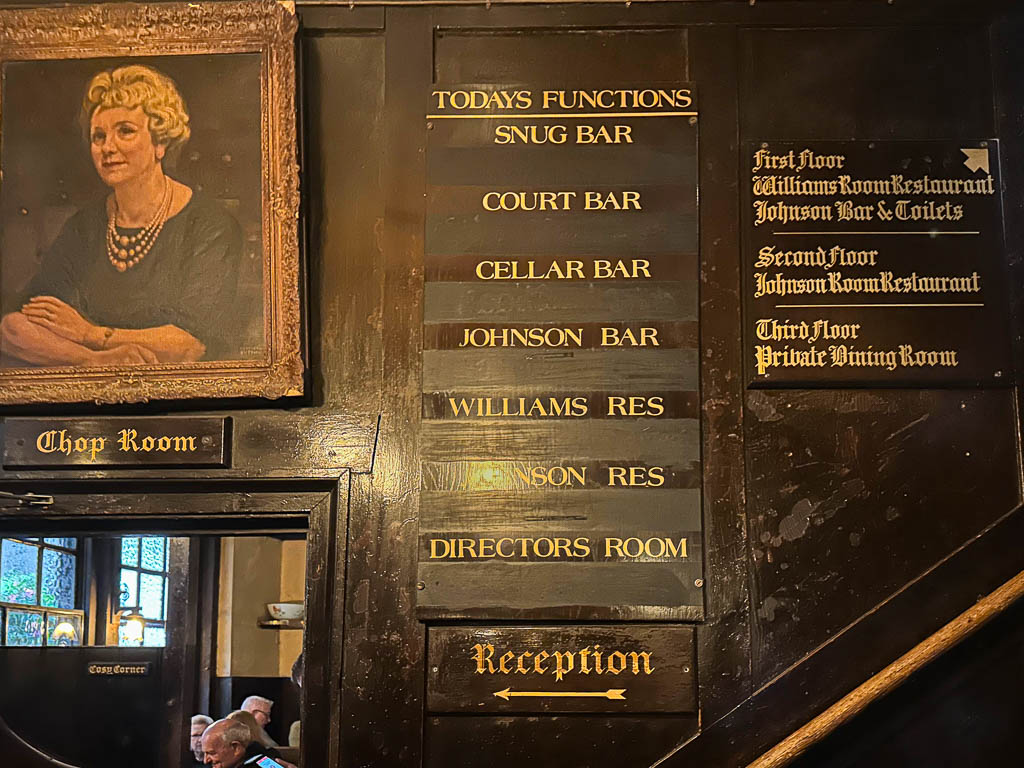
Interior wall of Ye Olde Cheshire Cheese pub. Photo by Jett Britnell
Established 1538
Location: 145 Fleet St, London EC4A 2BU, UK
Website: Ye Olde Cheshire Cheese
GORDON’S WINE BAR
“Wine is bottled poetry.”
— Robert Louis Stevenson
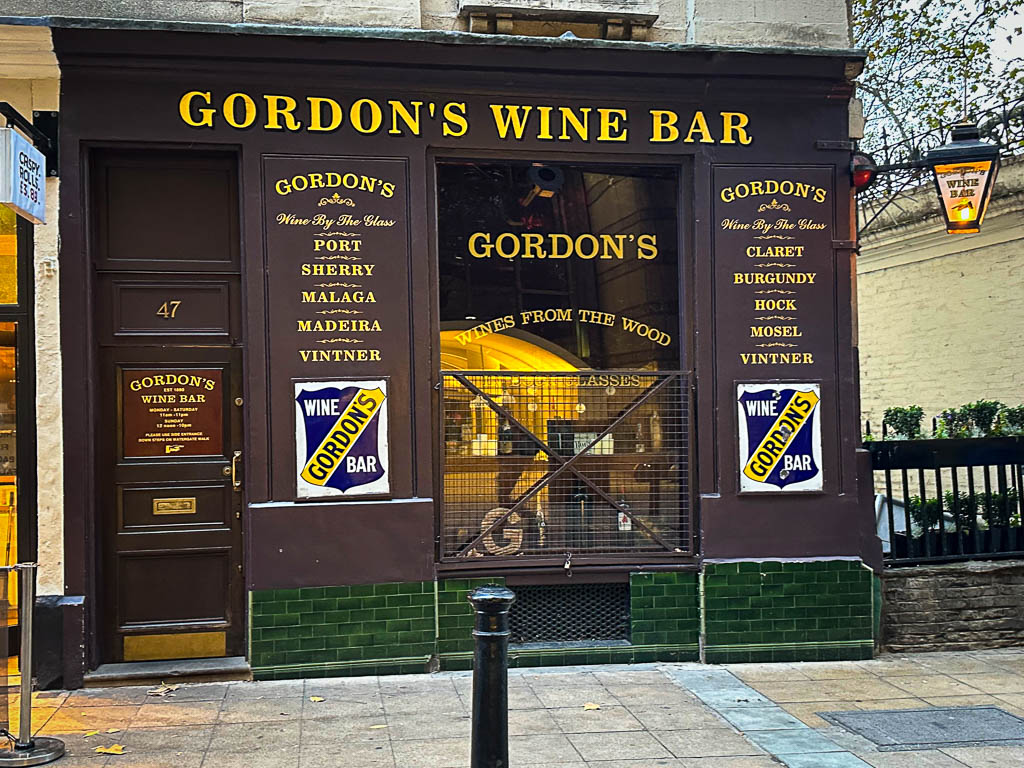
London’s oldest wine bar merited a shout out. Photo by Jett Britnell
So, why mention a place that doesn’t sell beer, but only wine? Well, we feel London’s oldest wine bar merited a shout out. You’ll love Gordon’s Wine Bar if you like cheese and port. The place does not take reservations as it has been first come, first served since they opened their doors in 1890. Situated on Villiers Street between Charing Cross Station and the Embankment underground, Gordon’s was once a favourite haunt of famed author Rudyard Kipling.
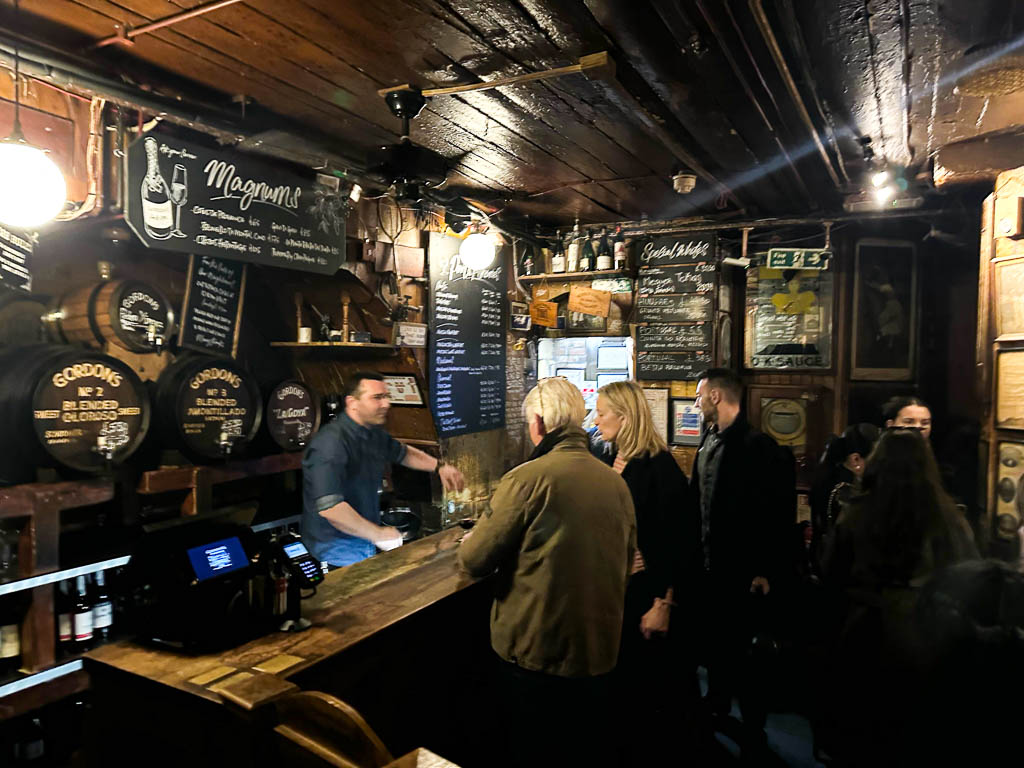
Gordon’s Wine bar. Photo by Jett Britnell
Entering through a discreet side door entrance on Watergate Walk, a steep creaking staircase into the subterranean depths of the wine bar where there are two main basement rooms. The first room has a relatively high ceiling, a bar with a small standing room and around six tables. The second larger cavernous space is dimly lit by candles and can seat about 30 people at eight or nine tables. The ceilings are low enough that taller people must crouch slightly to walk through. At one end of this chamber, there is a corner called the “cage” which is an old wine cellar that can seat approximately 10 people. Plastered on the wooden walls are historical newspaper clippings and a mishmash of faded memorabilia. Charcuterie cheese and meat boards reign supreme on the menu with generous slabs of cheese with slices of freshly baked French bread, salted butter, pickles, chutney & quince jelly that pairs well with their selection of award-winning wines.
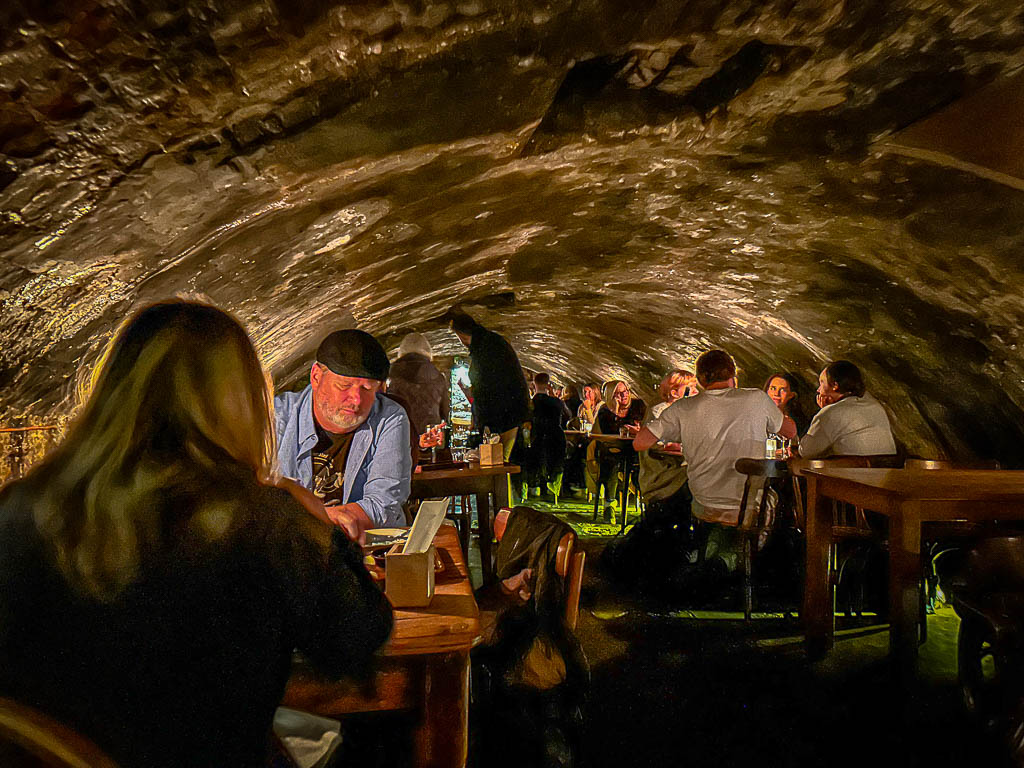
Gordon’s cavernous dining room. Photo by Jett Britnell
Apart from being a fabulous place to imbibe and dine, unbeknownst to us Gordon’s Wine Bar has acquired a reputation for some credited strange or unexplained happenings. Just as we finished our wine and were readying to leave, Kathryn said she felt as if she had been “tapped on the shoulder” a couple of times during the evening. She then pulled out her phone, googled it, and said, “Oh my, God.” It’s no big secret that Gordon’s is haunted. Some of their staff have experienced the heebie-jeebies from a feeling that they were being watched from a stygian corner of this cavernous bar. Several customers have also commented on the internet that they were “tapped on the shoulder” by an unseen ghost while dining here. The supernatural presence is believed to be the spirit of a delivery boy who died here after falling down the stairs. We had no idea.
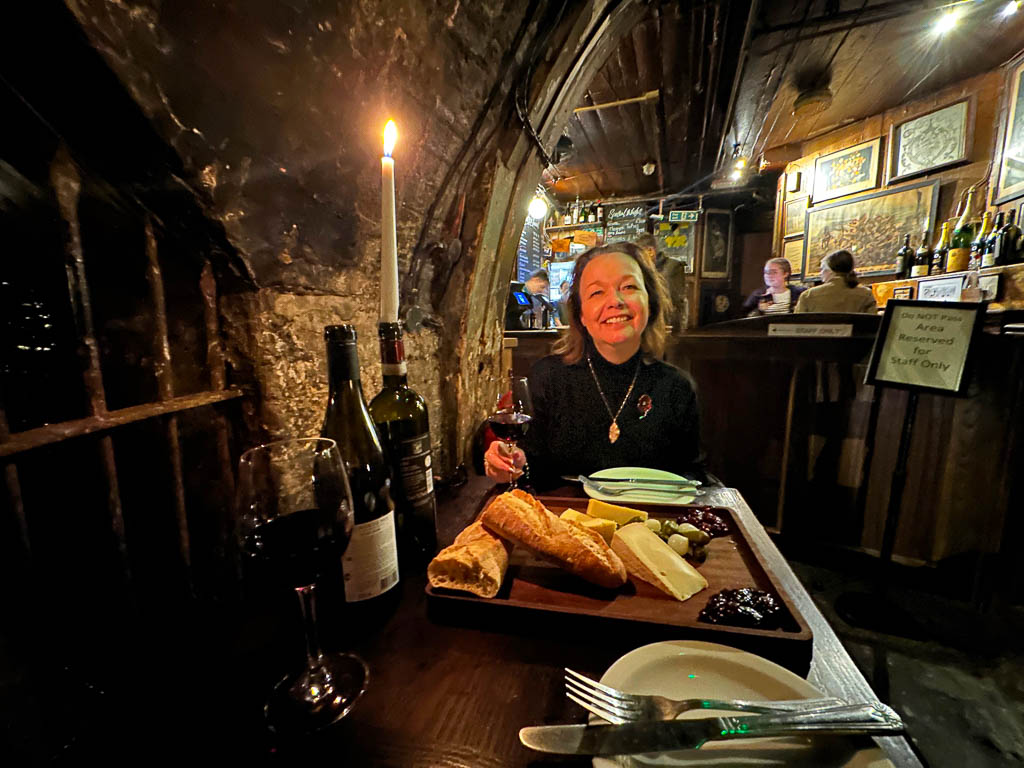
Kathryn said she felt as if she had been “tapped on the shoulder” a couple of times during the evening. Photo by Jett Britnell
Established: 1890
Location: 47 Villiers Street London WC2N 6NE
Website: Gordon’s Wine Bar
BRITISH PUB ETIQUETTE FOR FOREIGNERS
“He doesn’t stand his round”
(a damning indictment of somebody’s character.)
— English Pub Quote

British pubs are known to operate with some unspoken rules. When an uninitiated foreigner commits a breach of pub etiquette, the locals may groan, but following etiquette tips should get you up to speed quickly enough to make it appear you are a local pubgoer.
Sit where you like: Unless a table or seat is occupied by someone else, you can sit anywhere you choose in a pub.
Order drinks at the bar: Table service is not common in UK pubs, so it’s customary for one. or two, people go up to the bar to purchase drinks, then after you’ve been served carry the order back to the table.
Stand in queue: The pub’s bar counter is the only place in Britain where anything is sold or served without standing in the queue. The queue is still there, and the bar staff are aware of each person’s position in the “virtual” queue. Bartenders are generally aware of who arrived in what order. Simply smile and make eye contact with the bar staff and they will serve you the next chance they get. Patrons who reached the bar before you will be served before you.
Drink in rounds: Perhaps the most important English pub rule is to buy drinks in rounds. It’s customary for someone to buy the first round and then someone else reciprocates by paying for the next round and so on. Drinking in rounds is a British custom. Understandably, it’s considered rude to drink rounds all evening and not stand your round when your turn comes up. If you want to pay individually for your drinks, then order separately. The bar staff will total the cost when ordering as a group and expect a single payment. Before approaching the bar, know what you want to order in advance.
Your shout: It means it’s your turn to purchase a round. If someone else “gets a round in” you’re expected to reciprocate.
Never just ask for a beer: English beer is brewed in a variety of different styles such as IPAs, pale ales (also known as bitters), lagers, cask ales, stouts, porters, and sours. If you aren’t sure which brand of beer you desire, at least nail down a category.
Order slower drinks first: Some drinks need time to settle or take more time to make. Beer on tap, wine, and spirits, are the quickest to serve. Guinness takes longer to pour to allow time for the nitrogen bubbles to release. Mixed cocktails, coffee, and tea should be ordered before beer or cider.
And add one for yourself: Tipping is not expected, however, if you notice a tip jar, you’re always welcome to put a British pound in. Most of the time it’s better to offer to pay for drinks for the bar staff when ordering your drink and afterwards say, ‘and add one for yourself.” This lets the bar staff know to charge you for a drink on top of your order and they will then be able to enjoy a drink of their choice at the end of their shift.
Food orders: There is no single, correct way to order a meal or snack in a pub some take food orders at the bar, others may serve to take the food order from your table, and some have dedicated food counters for ordering.
Beer coaster on top: Do not sit where you see a glass with a beer coaster on tap as is the universal sign that a person at that empty table has nipped out to the toilet or for a smoke.
Don’t steal the glassware: you can stand and drink outside the pub. Be sure to return the glasses. The staff will appreciate it if you take your empty glasses back to the bar.
Last orders, please: The sound of a bell or flashing lights signifies its closing time or get your last orders in. After that, you’ve got twenty minutes to drink up.
“PRAY, RAISE YOUR GLASS…”
“Let’s drink the liquid of amber so bright.
Let’s drink the liquid with foam snowy white.
Let’s drink the liquid that brings all good cheer.
Oh, where is the drink like old-fashioned beer?”
— 19th Century Toast
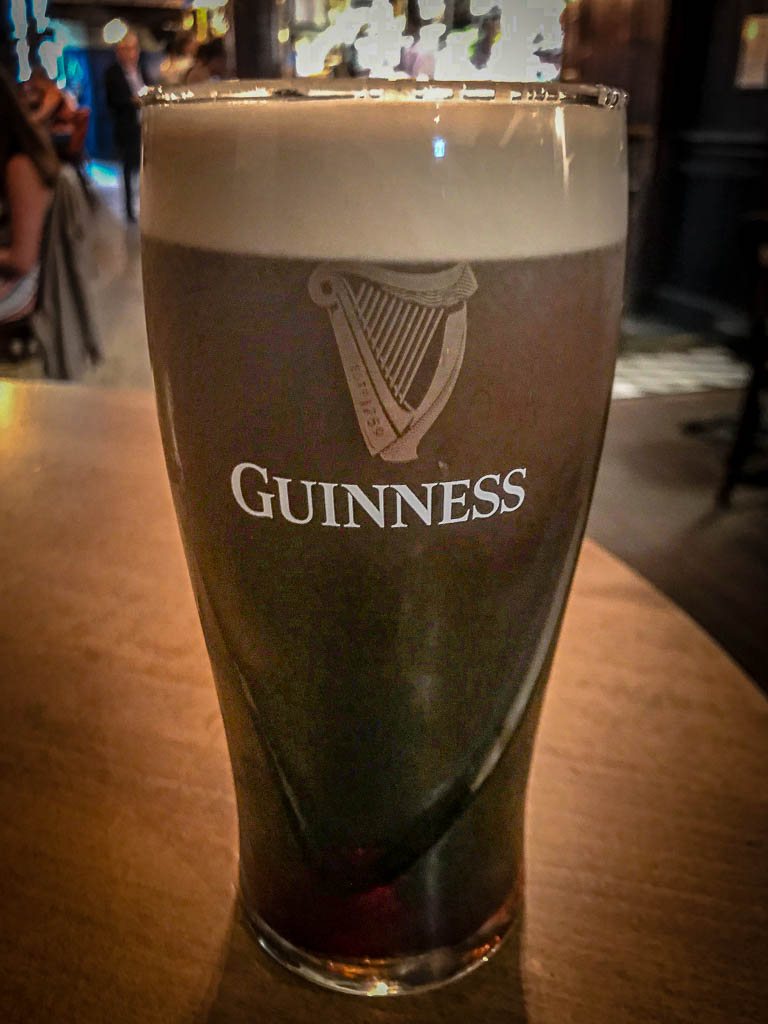
Guinness takes longer to pour to allow time for the nitrogen bubbles to release. Photo by Jett Britnell
To be immortal is living or lasting forever, or so famous as to be remembered for a long time, never decaying nor dying. A survey last year confirmed that as of June 30, 2022, Greater London had 3,580 pubs. Many of them are characterful historic drinking dens that have been pouring pints for centuries. If you ever happen to find yourself in one of the English capital’s watering holes, order a round, chat with the locals, pray, raise your glass of ale, and give a laudatory toast to London’s immortal drinking dens.
Until our next dispatch, dare to Explore…Dream…Discover.

